 Project 1144 Orlan; 4 ships built:
Project 1144 Orlan; 4 ships built:Kirov (1980), Frunze (1984), Kalinin (1988), Yuri Andropov (1988), Dzerzhinsky (cancelled).
1992: Admiral Ushakov, Lazarev, Nakhimov, Pyotr Velikiy (2 BU, 1 refit, 1 service 2023)
The Kirov class missile cruisers were nuclear-powered vessels built by the Soviet Union in the 1970s-1980s as Project 1144 Orlan. Kirov (later Admiral Ushakov), Frunze (later Admiral Lazarev), Kalinin (later Pyotr Velikiy), and Yuri Andropov (later Orlan) were designed as multi-purpose warships ranging from anti-ship and AA warfare, and provide long range strike support in amphibious landings. They were well rounded with guns, missiles or four types, rockets and torpedoes, and with advanced armor and electronics. Their nuclear reactors, something new in the Soviet surface fleet, gave them the required unlimited range and top speed required for ocanic operations. They perfectly incarcated the will of Soviet Navy in the 1980s to be present on all seas, and after being revealed, influenced the Reagan administration into promoting the idea of a “600 ships fleet” as well as reactivated the four Iowa class battleship for full modernization. The most powerful and advanced warships of their time, they were not only influencial, they stays today as a benchmark of what a classic missile armed surface warship can be and will motivate naval historians to take them as example for centuries.
A long development history
General context
The 1960s were a period of drastic changes in the Soviet Navy. After the death of Stalin in March 1953, new PM Nikita Khrushchev obliterated “old school” soviet naval plan calling for battleships, battlecruisers and long range cruisers. Only for the latter, the Sverdlov were completed. Instead, a complete turn was made on quality high-technologic solution as a solution to balance the asymetry with the USN, still seen relatively classic at the time. The Navy embarked on a plan to field missile armed cruisers as “carrier killers” and submarines. This vision shaped the evolution of the cold war navy for decades, and the need to seek truly unique and original solutions that today are the subject of memes: The Ekranoplane, giant hovercrafts, hybrid carriers (Kiev), giant ballistic (Typhoon) or cruise missile (Orcar) submarines… and giant missile cruisers: Project 1144 Orlan.
As soon as antiship missiles were developed, it was understood that the US and NATO would develop counter measures: SAM missiles used to intercept incoming missiles (like the sea sparrow), antimissile guns (CIWS, already Phalanx developed them in the 1960s), Chaff launchers (like the SUBROC) and electronic warfare systems. In response to this panoply, the 1960s naval staff had several ideas in mind. One was to develop a new type of missile that would be jamming-proof, had very low trajectories, and too fast to be intercepted (mach 4), of course in case of war also tipped with tactical nuclear warhead. An other idea was how to use them. The idea ws to create a saturation fire from several angles on a big, juicy target: The Carrier Battlegroup (CBG).
One or two task surface antiship forces would converge on target, and two ore more SSGN (cruise missile armed submarines) from other angles and directions. The idea was to completel overwhelm all these defence systems enough for several of these nuclear-tipped supersonic missiles to hit their target.
A “super Kara” class ?
The original project in the very end was in part to succeed the Kara class (Project 1134 Berkut B), which were ASW cruisers. Indeed, they were originally conceived to counter the U.S. Navy’s submarines like the Ben Franklin class SSBNs, being centered around their SS-N-14 anti-submarine missiles. This is the evolution that saw the latter inclusion of twenty P-700 Granit anti-ship missiles to attack carrier strike groups which is indeed interesting. Later they were intended to operate alongside new nuclear-powered aircraft carriers (Alternative design to the Kiev class, larger, cancelled, reborn as the compromised Kuznetsov class) for global power projection. However several designs led to a “combination cruiser”, a mixture Project 81 and 63 and later the a paired project ships to be deployed in ASW chase. One became Project 1144, the other Project 1143.
Development history
The initial impetus started well before that: On August 25, 1956, a Resolution of the USSR Council of Ministers No.1601-891 called for the “creation of ships with new types of weapons and power plants in 1956-62”. It define the shipbuilding program for 1956-60 and was confirmed by the May 18, 1957 program for a guided missile cruiser to be defined for the next 5 years. TsKB-17 (later Nevskoye PKB) was issued requirements for the development of the light missile cruiser project 63 under chief designer A. Savichev. TsKB-16 (TsPB “Volna”, later SPBMB “Malachite”) being entrusted with the development of a new air defense ship, Project 81. Both were supposed to have nuclear propulsion and be capable of 32 knots. In early 1957, based on initial considerations, pre-design studies, sketches and and preliminary designs by CiC S.G. Gorshkov, project 81 was suspended.
In July 1957 however Project 63 was approved, and preliminary design was supposed to be ready later that year, and technical blueprints ready for the third quarter of 1958. NII-8 (N.A. Dollezhal Research and Design Institute of Power Engineering) was tasked of its development by November 1957 and worked on a nuclear powerplant and to study the installation of no less than 18-24 large missiles of the P-6, or P-40 in development, with an alternative variant with P-20 missiles. The laying of the lead ship of Project 63 was even planned at plant No. 189 in Leningrad with delivery to the fleet planned for 1961. No. 189 and No. 144 Baltic shipyard plants were supposed to deliver no less than seven nuclear-powered cruisers of Project 63.
Preliminary designed were submitted for consideration to the State Committee in July 1958 but approval was delayed. In addition the committed warned that the feasibility of creating such ships with weak protection from air strikes was dubious at best. As a result, the Council of Ministers on December 3, 1958 and confirmed in March 1959 stopped any work on Project 63.
With the advent of nuclear submarines in the US Navy, which could operate far beyond the so-called “far zone” 150 miles deep around our national waters, the question of fighting them became acute. To effectively search for and destroy nuclear submarines, as was then believed, we needed escorts with nuclear power plants. In the absence of aircraft carriers, it was necessary to develop a “pair” theory: One ship searched for nuclear submarines, and the other guarded her. Moreover, both were equipped with powerful missile systems, i.e. the escort ship could also participate in the search and destruction of submarines. Another thing is that in order to effectively track all enemy submarines, there must be at least 50 such ships…
A. SOKOLOV – shipbuilding engineer, gunsmith, “Soviet missile cruiser. Zigzags of evolution” 2006.

Long-range air defense ship Korshun missile defense system
In 1963-66, development of the Korshun universal missile system for long-range anti-aircraft defense was started. They were peculiar in having ammunition stored in three bow magazines.
To combat surface ships, submarines and aircraft altogether as later precised in the TTZ, the new cruiser was supposed to be equipped with at least two types of missiles, universal (SAM/SSM) and anti-submarine. The equipment was developed based on requirements to ensure simultaneous firing of 8 targets by 16 missiles. The universal missile range was setuo at 75-85 km, and the ASW missile at 100-150 km. Respective ideal lenght of the missiles was 5.9 and 7.15 m respectively, launch mass 2,033 and 2,313 kg. The nex project was to have from 48 to 80 universal and 12-16 anti-submarine missiles, launched using powder pressure accumulator at 15° elevation from below-deck launchers (VLS).

Project 1143 Krechet, initial proposal which will end with the Kiev class.
Initial Project 1144 Orlan long range air patrol ship (a much smaller proposal)
The planned pair soon broke up and diverged. One became the basis for Project 1144 Orlan (the protectors) and the other Project 1143 and the code “Krechet” acting as regular helicopter carriers (future Kiev class).
Meanwhile development went on with nuclear propulstion at sea, with the first submarines (“Novermber” class or Project 627 Kit in 1957) and in 1959, the world’s first surface vessel with a nuclear power plant, icebreaker Lenin. In the US however, 1961 saw the first nuclear-powered guided missile cruiser, USS Long Beach entering service.
This created further impetus for a combat nuclear-powered surface ship presented by its advocates like a logical evolution of naval technology.
After all, the USN at the time worked on an “all nuclear” surface battlegroup, comprising the center, aircraft carrier (USS Enterprise), escorts (Long Beach and planned nuclear-powered destroyers). However HG Rickover in charge of the destroyer propulsion diverged attention on submarines instead, leading to the creation of USS Nautilus, a powerful subject of concern with the Soviet Navy, at the heart of a deep evolution from naval to air, to ASW threat management.
Project 81: The AAW Kirovs
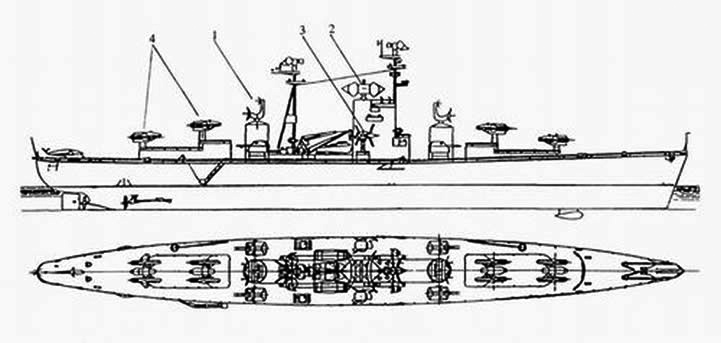
Radical proposal for a nuclear powered air defence cruiser without any anti-ship, in parallel to Project 63. Pure air defence ships ordered by Admiral Gorshkov combined under Project 63 to be approved. Project 81 was less developed and much smaller.
20 000 tons, 207 x 21.8 x 7.8 m, 3-6 nuclear reactors 120,000 hp on 3 shafts, 32 knots, same protection as Project 63. 4×2 SM-68 M-3 SAM forward and aft (40 V-800 missiles) with secondary anti-ship capability up to radar horizon. M-2bis alternative slaved to Korvet-sevan (Fan Song E) radars. 4×2 SM-52 (100-mm) or SM-62 (130-mm) port and starboard (four corners) controlled, 2x RBU-2500 bow, 2×4 533-mm TTs weather deck, helicopter pad, no hangar. Taifun, Angara, Razliv, Don, Krab, Bizan radars, Kuznechik TV, GAS-372 Gerkules sonars.
Overall decision was made to combine both this and Project 63 decision in a more massive, AA and ASuW warfare ship, albeit massive.
Project 1126
Anti-aircraft escort cruiser for the Moskva Class, with antiship capability, studied 1960-1961 in TSKB-17 under P. P. Milonov. pic. 10,000 tons displacement, 33-34 knots 3,500 miles range at 24 knots. Twenty variants examined from 6,200 tons to 11,000 tons (speeds 29.7 kts to 35.5 knots with Steam turbine but also Nuclear plants, gas turbines, Diesel and COSOG turbines) By July 1960 the final project 1126 measured 196 x 24.25 x 5.36m for 9,000 tons in displacement, 2-4 pressurised water nuclear reactors 2x 45,000 hp steam turbines 32-33 knots. Armament: 2×2 SM-68 or SM-69 forward and aft (M-3 SAM, V-800, 10 per launcher): 20m, 55km range, 195kg HE warhead, “Fregat” FCR director, development never completed.
Other variant 2×2 M-31 Naval SAM with 2K11“Krug” (SA-4 Ganef) (2×10 reserve), beam riding, semi-active radar homing, with Pat Hand FCR.
2×2 B-189 M-11 Shtorm Naval SAM (V-611 missile, SA-N-3) 18-36 per launcher with 6-silos drums as for the Moskva class when projected.
Four AK-725 twin 57-mm gun mounts, 2 x3 21-in TTs, 2x RBU-1000 rocket launchers, Ka-25 helicopter (no hangar). electronics close to Project 1123 Moskva: MR-600 Voskhod (Top Sail), MR-310 Angara (Head Net C), Don radars, MR-103 Bars (Muff Cob), MG-312 Titan, MG-311 Vychegda sonars.
Project 63

Design variant, evolution of Project 1126, non-nuclear but far larger. as designed by V. Yakubov and drawned by V. P. Kuzin’s as a forerunner for the Project 1144 Kirov. Drawing number 3 was stating a displacement of 16 000 tons, speed of 32 knots. It was to have three retractable launcher (P-40 cruise missiles), two forward, one aft and 3-4 more tubes trainable and reload for each tubes, 18-24 missiles total. Two twin SM-68 launchers, M-3 SAM (V-800 missile) forward and aft, 10 each, 20 total.
2×2 Zif-101 launchers for the M-1 Volna SAM system (SA-N-1) (2×8 drums each, 24 total)
2×2 76mm AK-726 mounts, 2x RBU-2500 ASWR, 2x Fregat SAM FCR 2x Tenzor (Scoop Pair) FCR (P-40), 2x MR-300 Angara radars (Head Net A), 2x Razliv (High Lune) HF radars, Taifun Long range air search radar, 2x MR-105 Turel (Owl Screech) gun FCR, 2x Yatagan (Peel Group) M-1 Volna FCR.

Project 63 variant
The sub-variant design Eh-4 reached 19,830 tons in displacement for 225 x 22.5 x 7.84 m, pretty closer to the Kirovs, and powered by a single nuclear reactor, four turbines, 30,000 horsepower each, 32.5 knots. The biggest difference was the armour Belt of 75 mm, up to 200 mm over reactor spaces plus an upper armoured deck of 20 mm up to 150 mm over reactor spaces. There was a bottom armour from 75mm to 100 mm again around the reactor spaces.
Final Armament as listed was:
-2x P-20 cruise missiles plus 2×4 SM-76 trainable missile launchers
-2×2 SM-68 launchers M-3 SAM (10 each), slaved to 2 Fregat radars.
-2x Zif-101/M-1 Volna (SA-N-1 Goa), 2×16, slaved to Yatagan (Peel Group) radars.
-2×2 AK726 76-mm slaved by Turel (Owl Screech) GFC radars.
-2x RBU-2500 bow ASWRL.
-2x Ka-25 helicopters with hangar aft, lift.
-Taifun, MR-300 Angara, Razliv, Tenzor, Krab (Top Hat), Bizan (Watch Dog), Nickel-Khrom systems, 7x Kuznechik TV systems, 2x GAS-372 Gerkules sonars.

Project 63 variant
Sub-variant IL-2 225 x 22.5 x 7.84 m, 1x nuclear reactor, 4x turbines 32-33 knots. Thicker armour, armament revised: 2x P-20 strategic cruise missiles aft, 2×4 SM-76 trainable launchers P-40 forward, 2×2 SM-68 M-3 SAM, 2×16 Zif-101 M-1 Volna, 2×2 AK726 76-mm, 2x RBU-2500, 1-2 Ka-25.
Sub-variant XN: 179 x 19 x 5 m (7.2 m oa) 2x oil-fired pressure-fired steam engine as KV-41 (Project 41 Tallinn), 100,000 hp, 32 knots. Armed with 4×2 2-level container launchers port and starboard P-35/P-40 SSM. 8 ready, elevated to 20°before launch. 2×2 SM-68 M-3 or M-2bis (SA-N-2 Guideline) slaved to Korvet (Fan Song E) radars.
2×2 SM-62 100/130-mm forward and aft, adopted for Project 68bis cruisers, Project 56 destroyers (130-mm).
2x RBU-2500, quarterdeck, 2×3 533mm TTs. Radars MR-300 Angara, Tenzor, Don, Krab, Bizan, Kuznechik TV systems, GAS-372 Gerkules sonars.
Sub-variant VIII 250 x 26.4 x 6.7 m (8.4 m oa), 4-8 reactors, 4 steam turbines 30,000+ hp each 32 knots. Armour like previous proposals.
3×5 trainable launchers P-40/P-35 SSM, 2 forward, 1 aft, 15 reloads with cranes. 4x Zif-101 launchers M-1 Volna (SA-N-1 Goa) port and starboard, drum reload, Yatagan radars.
6×2 SM-62 100/130-mm port and starboard, Turel (Owl Screech) GFC radars, 2x RBU-2500, bow, 2-4 Ka-25 helicopters and hangar below deck, stern lift.
Radars MR-300 Angara, Tenzor, Don, Krab, Bizan, Kuznechiksystems, GAS-372 Gerkules sonars.
1964: True launch of the program
Research to determine the appearance of the first Soviet combat nuclear-powered surface really started by 1964, and the main reason of this delay lied in N. S. Khrushchev’s well-known views on the role and development of the Navy and on large surface ships (which he rejected). However gradually the objective of the fleet with ocean-going capabilities capable of operating in remote areas as part of a group or independently in anti-submarine missions became the focus of any nuclear-powered vessel.
There was a new tactical and technical assignment (TTZ) that year for the development of a large nuclear-powered anti-submarine ship rated at first at 8,000 tonnes under the lead of B. Kupensky, who had previously worked on the first Soviet gas turbine for project 61, as chief designer. From the Navy, main supervisor was Captain 2nd Rank A. Savin. Her was a Navy specialist leading a team bringing military and scientific support to the development at all stages of the design, construction and testing, which required knowledge, erudition and experience in most matters, making him equal to the chief designer. Fortunately for the project, B. Kupensky and A. Savin turned out to be good, cooperative and friendly working partners.
In the shadown still however former Commander-in-Chief S. Gorshkov intervened as he loved to deal with issues of construction and design. As a rule, he generally made competent decisions. In fact, the new project became his favorite brainchild but the design process soon appeared difficult and rather slow. The design saw a constant shift up in displacement foring to look for more options for the main power plant and layout issue prevented for the start the adoption of existing nuclear plants either from the Icebreaker or submarines due to layout issues.
The decision to create the “special power plant”, CONAS, was very much the result of a demanded from the CiC, fearing reliability issues due to recent experiences with the November class submarines…
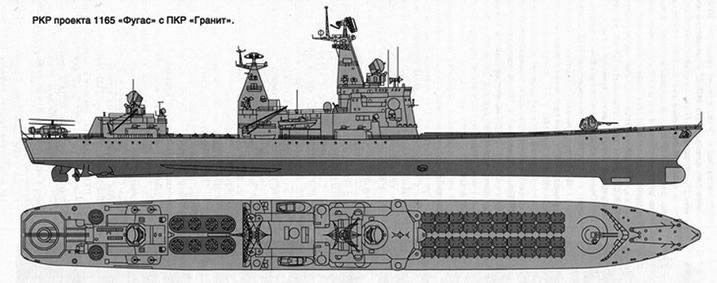
Alternative Project 1164 Slava design, cancelled.
Project 1144 Orlan Main development
The development of the project was entrusted to the team of the Northern Design Bureau in Leningrad, B. I. Kupensky, who had previously been the chief designer of the first domestic gas turbine EM (BOD), was appointed chief designer and head of the design team. From the Navy, the main supervisor of the design and construction of the ship from the very beginning to the final transfer to the fleet was Captain 1st Rank A. A. Savin and both worked together for the design to be finally approved in 1971, and the first ship laid down in 1974, followed by the other three in the same Baltic shipyards, Leningrad. The team led by Admiral Gorshkov for Project 1144 Orlan was to be initially 8,000 tons at the most. But studies gradually led to more realistic standards of 20,000 tons as more specifications and armament were combined. This explained the 1964-1971 design time. The Kirov thus could act as flagships or command ships of the fleet and they were assigned to the Baltic, Northern Fleet, Black Sea and Pacific Fleet.
From 1977 to 1996, according to project 1144, four out of seven initially planned heavy nuclear missile cruisers were thus built at the Baltic Shipyard, armed with almost all types of weapons in the Soviet inventory at the time, the maximum designed for military surface ships. They made a statement, being massive and still, seemingly virgin of any visible weaponry on their long forecastle. This was specific to the early VLS system, entirely hidden within the hull.
On March 26, 1973, the Baltic Shipyard began construction of the first lead ship of Project 1144, Kirov which was reenamed from 1992 untim decommission in 2004 Admiral Ushakov. She was launched on December 27, 1977, and after a complicated first fitting out, completed on December 30, 1980, accepted for service in the fleet. 1973-1980 is a long time for building a modern warship (seven years) and gives a clue of the complexity, size and challenges linked to the new warship type. On October 31, 1984, Frunze (1992, Admiral Lazarev) was commissioned in turn, then by December 30, 1988, Kalinin (1992 Admiral Nakhimov).
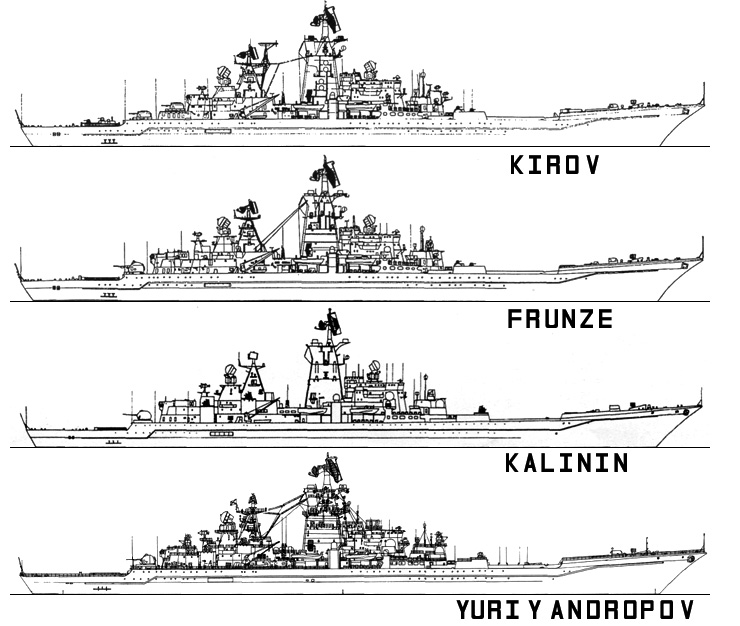
With the rapid collapse of the Soviet Unition the fourth ship, started in 1986, Kuibyshev (“Yuri Andropov”, then “Pyotr Veliky”) planned for a completion in 1992, was only completed by 1996, and tested in the harsh conditions of the Arctic. In April 1998, at last she was commissioned. The delay meant she would be upgraded and ended as the most capable of all four sisters.
In total, the program for the construction of nuclear cruisers involved 7 units. Of the planned cruisers on December 30, 1988, the fifth Dzerzhinsky corps was added to the lists of the Navy, then, at the request of the sailors, it was renamed Admiral Kuznetsov. On May 9, 1989, it was laid down under serial number 804, but on October 4, 1990, along with others, it was removed from construction. The sixth was supposed to be called “Russia” (listed on December 30, 1988), the seventh “Varyag”, there is no information about other ships of project 1144.2.
Design of the class
Hull and general design
Hull and superstructure design:
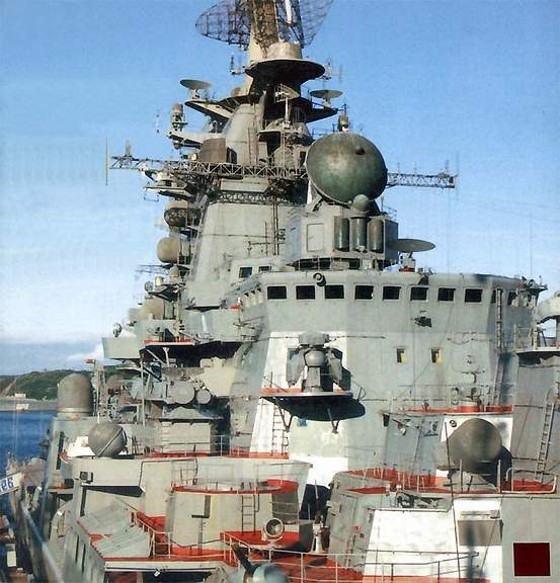
The Kirov was the largest missile cruiser ever built, with a displacement Standard of 23,750 t and fully loaded of 25,860 t for an overall length: 250.1 meters, a width overall of 28.5 m and maximum draft of 10.3 m. For references, this ws as large a a battleship of WW2 such as the Bismarck. The difference in displacement, almost half less, being explained by the absence of armour at the same level, and other heavy equipments proper to a battleship. The ships were functional yet relatively pleasing to the eye, with a raised, sharped bow, long clipper style forecastle with bulwarks, long straight middle section, forming a perfect rectangle, and ending in a lower stern deck and rounded semi-transom stern, almost as large as the hull mid-beam.
The silhouette was impressive. Although the forward section looked bare, the gradual superstructure ending with the tall bridge, and massive fore and aft mack, carrying large aerial radars, then gradual stepped aft structure ending with guns, made for a well balanced appearance overall. Unlike the Slava, they were more in the tradition of the previous Kara-Kresta albeit on a much larger scale for their general outlook. The relatively compact and tall centre structures and long, stepped forecastle and equally long aft section instantly recalled the silhouette proportions of a capital ship of ol. They surely were intimidating, formidable vessels when seen in any port, perfectly playing the role of reassurance when showing the flag in Soviet friendly nation’s harbours. They were also a statement of diplomatic muscle flexing when deployed in any contested area.
Internal arrangements:

There are about 1,600 rooms on the ship, including 140 single, double and quadruple cabins for officers and midshipmen, more than 32 cabins for sailors and foremen (for 8-34 ratings each), corridors, ladders and a vestibule for a total length of almost 20 kilometers, more than 30 showers, two baths, one sauna with a 4×3 m pool, a two-storey medical block with infirmaries with isolation rooms, a pharmacy, an X-ray room, an outpatient clinic, a dentist’s office and fully equipped surgery operating room. That was more amenities than in any previous soviet cruiser, another novelty for the crews, which felt priviledged to serve on board in the eighties. The doubled power plant of project 1144 could theoretically provide electricity and heat to the ship in any condition, either on nuclear power alone, or steam turbines alone, providing enough power to serve a population of more than 150,000 inhabitants. In all, this power was “just” for 744 crewment, including 101 officers, 130 warrant officers, 513 sailors and the 18 flight personnel dedicated to the three Kamov helicopters.
Armour protection layout
project 1144 ships had the following scheme:
-SSM compartment: 100-70mm (4-2.7 in) sides, 70mm roof (2.7 in)
-ASuM magazine: 100-70m sides (4-2.7 in), 70m roof (2.7 in)
-Conning Tower and command centre: 100-75mm sides (4-2.7 in), 75mm roof (2.7 in)
-Hangar, aviation fuel tank and magazine: 70mm sides (2.7 in), 50mm roof (2 in)
pr. 11442 (Yuri Andropov) No ASuM.
Powerplant
The Nuclear power plant comprised in the end four KN-3 reactors (core type VM-16), a variant of the icebreaker reactors OK-900 type but with significant differences. The most important was that fuel assemblies manufactured by Elektrostal, containing highy enriched uranium (about 70%). This was to ensure the core change every 10-11 years. Reactors used a standard double-circuit, water-cooled, and thermal neutrons. High-purity water (bidistillated) was used as moderator and coolant, circulating under high pressure (200 atmo) through the reactor core, providing boiling water in the secondary circuit, which then went in turbines as steam.
Particular attention was paid to working out the complex double power plant arrangement (CONAS), with a 140,000 shp output: 90,000 for the nuclear plant, 50,000 for the GTZA-653 steam turbines. The automated nuclear power plant was located in three compartments with the two nuclear reactors in their own managing to deliver a nominal ouptut estimated to 342 MW passed on to two two turbo-gear units located forward and aft of the reactor compartment, then two backup automated boilers KVG-2, installed in the turbine compartments.
The steam supply system enable circulation in any installation aboard, not only turbines. The KVG-2 boilers worked with superheated steam at a pressure of 66 kg/cm² and 470 degrees Celsius, with an efficiency up to 84%, coupled with a dry boiler weighting 50 tons. Steam capacity was 115 t/h. These are probably the largest, most efficient naval boilers so far. There were four 3 MW steam turbine generators in all, plus four 1.5 MW gas turbine generators, made by the Proletarian Plant. Each was in its own autonomous compartment. Each was rated for contsant use before revision of 50,000 hours.
Performances
At full power, with both nuclear and steam, a Kirov class is able to reach 32 knots (59 km/h), whereas in operational and economic cruising on steam alone, it could be at 18 knots (33 km/h), with the notive that the nuclear powerplants could run an lower power in any case as well. Endurance was 60 days, radius of action, based on an oil bunkerage of 1,120 tons, the ship could still manage to reach 1,300 nautical miles at 17 knots, under oil-fired boilers only. It was unlimited with the nuclear power plant. Others sources states 1,000 nmi (1,900 km; 1,200 mi) at 30 knots (56 km/h; 35 mph) (combined propulsion) and unlimited at 20 knots (37 km/h; 23 mph) on nuclear power
Armament
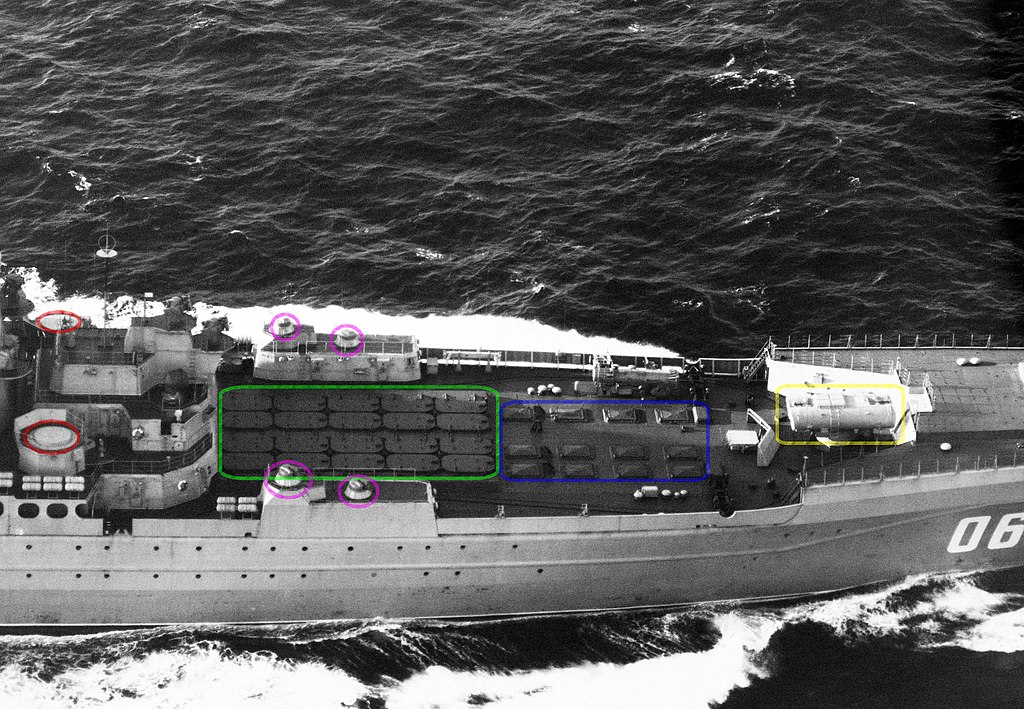
Aerial photograph of the bow of the Kirov: 4 AK-630 30-mm air defense ship mounts 2 Osa-M surface-to-air anti-aircraft missile launchers 20 wing launchers. Granit missiles 12 S-300F missile launchers Metel anti-submarine missile launcher
All four built cruisers differ quite significantly from each other in the composition of auxiliary weapons, which improved over time. In this regard, “Kirov” refers to the project 1144, and the remaining three cruisers – to the project 1144.2. Even project 1144.2 ships were not identical in armament composition:
Kirov (Pr.1144): Separate launcher for the Metel ASuWM and the “Waterfall” system was launched from torpedo tubes. There were only two AK-100 guns installed, one AK-130 on the next three.
Self-defense air defense on the single 1144 and first two 11442 comprised two twin “Osa-M” (40 missiles) launcher. One the last 11142 “Peter the Great” they were replaced by eight octuple “Dagger” (64 missiles) systems. On “Kirov” and “Frunze” (later Admiral Lazarev), there were bow RBU-6000 “Smerch-2” ASWRL, while on the last two, “Kalinin” (Admiral Nakhimov) and Peter the Great there were RBU-12000 “Boa”. On the Kirov and Frunze close defence was ensured by eight ZU AK-630 CIWS, while Kalinin and Peter the Great had six of the new 6 ZRAK “Kortik”, combining cannons and short range SAMs.
RCC “Granit P-700” SSM

The P-700 Granit (NATO SS-N-19 Shipwreck) is an anti-ship/ASW supersonic cruise missile, 3rd generation with a reduced flight path profile. This is a massive ordnance, 10 m long for a diameter of 0.85 m, launch weight of 7 tons, flying at mach 2.5 and carrying a 750 kgs HE warhead or nuclear 500 kt one at up to 625 km. The conventional warhead uses a fuel-air system to cause a volumetric explosion. The Granit had an inertial guidance system with radio command and datalink (provided by relay planes) for adjusting the flight path, and active radar homing system for the final section at 37 km from the target. Propulsion relied on an annular solid propellant booster for the launch and first leg, and then by mid-flight a turbofan engine KR-93.
The over-the-horizon target designation and guidance could be assured by a Tu-95 RTs turboprop aircraft, but also a Ka-25RTs helicopter or even satcom, with the Legend-M satellite. The missile is designed first and foremost to attack a carrier strike group, the entire formation with its nuclear warhead, or hit a carrier with conventional one. It could be setup for inland strikes as well, and they can be integrated in the general deterrence assets of the Naval Strategic Nuclear Forces.
Twenty P-700 Granit are present in a VLS, below the weather deck, the tubes being slanted at an elevation angle of 60°. The SM-233 launchers were manufactured at Leningrad Metal Works. Since the Granit missiles were originally intended to be launched from submarines, the launcher is filled with outboard water before launch. Project 11442 ships had the P-700M not controlled after launch. In the rapid fire/saturation mode, one missile, acting as reconnaissance vector, flies on a high trajectory to maximize target acquisition area, the other missiles flying on lower trajectories.
In flight, missiles had a datalink also to exchange target data and coordinate. If the recon vector is intercepted, another other missile automatically takes over and start a high trajectory in turn to illuminate the target. The P-700 had been made proof against radio interference. The high command estimated interception risks to be very low due the missile’s enormous mass and terminal speed when reaching the target. Estimated where that when a Kirov launched half its P-700 missiles in short succession at a US CBG (Carrier Group), chances of hitting several times the carrier with conventional carrier and its escorts were above 90%, and 100% with the nuclear tipped ones. Proportion between the nuclear and conventional tipped p-700s was classified and remains so.
SAM “S-300F”
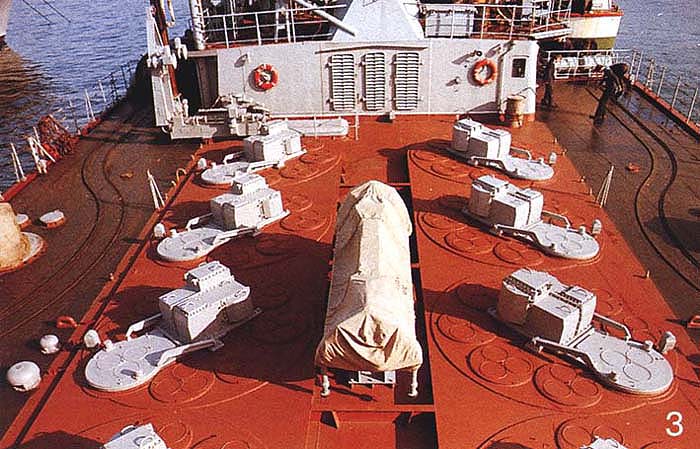
S300F on Slava – credit en.missilery.info
The S-300F (SA-N-6 Grumble) was however introduced in 1984 as the original ship-based S-300P from Altair and 5V55RM missile, range 7–90 km (4.3–56 mi; 3.8–49 nmi) speed Mach 4, and 82–82,021 ft altutude. The system receives data from the TOP SAIL radar and 3R41 Volna (TOP DOME) radar with command guidance with terminal SARH mode. It was first installed on a Kara-class cruiser, Slava-class cruisers and of course installed as standard in the Kirov-class battlecruisers, stored in twelve 8-missile rotary launchers below decks.
The S-300 Fort-M (NATO SA-10 Grumble) shipborne air defense system uses 48N6 missiles introduced in 1990 for the last ship of the serie, Peter the Great. Top speed was increased to 1800 m/s. The warhead reached 150 kg with a 5-93 km radius, the 48N6 range being 150 km, but with 1993 control systems, only 93 km, altitude 25 m to 25 km. Guidance system uses the onboard radar for short-range ballistic missiles interception.
Infrared guidance system to alleviate interference is also used, and it can destroyer over the horizon or outside of radar visibility targets like warships or anti-ship missiles.
The new S-300FM Fort-M complex and guidance radars was proper to the Pyotr Veliky and the 48N6 missiles were replaced by the 48N6E2 (200 km range, improved ballistics and greater explosion, unified with the S-300PMU2 land system). Design features made it larger, reducing the total VLS load to 46. Peter the Great had one VLS with 48 48N6 missiles, and one S-300FM with 46 48N6E2 missiles.
Gunnery
AU AK-630 – ZRAK “Dagger”
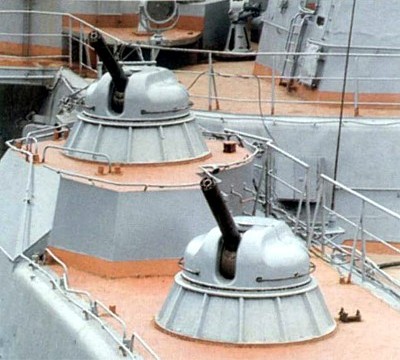
ZRAK Kortik (CADS-N-1)
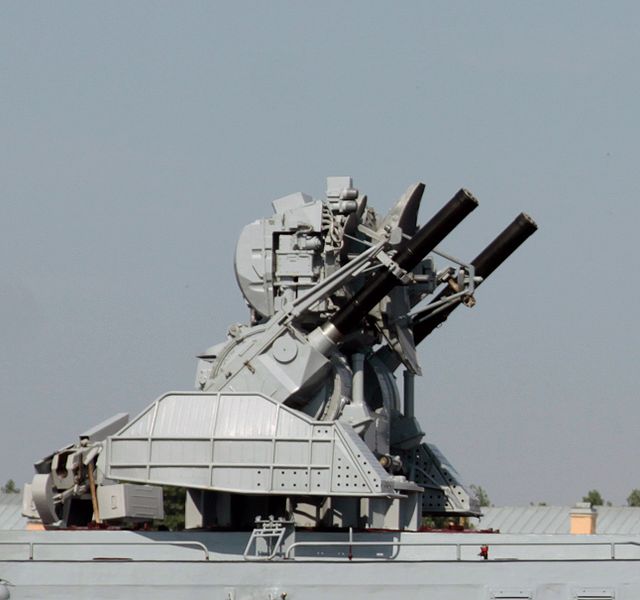
The cruiser “Peter the Great” is given the actualized artillery complex (ZRAK) “Kortik” (NATO CADS-N-1) with radar and TV optical modes and full automation from detection to destruction. There are two 30-mm six-barreled AO-18 antimissile superfast autocannons (rate of fire of 10,000 tpm) completed for short range by two four two-stage 9M311 (SA-N-11) missiles with fragmentation-rod warhead and proximity fuse. There are 32 missiles in the compartment in launch container, capable of hitting anti-ship missiles, guided bombs, small aircraft, and helicopters.
The missiles are unified with the 2S6 Tunguska land system. Its Kashtan control system consists of radar and TV systems interconnected, using IA. The whole process from detection to illumination, and fire is fully automated and can use both the missiles (larger bubble) and fall back to cannons closer. The missiles had a range from 1.5-8 km, completed by artillery at the lower bubble, 1,500 down to 50 m. Max ceiling is 4,000 m. Four others systems are located in the aft superstructure for six total on Peter the Great.
“AK-130”
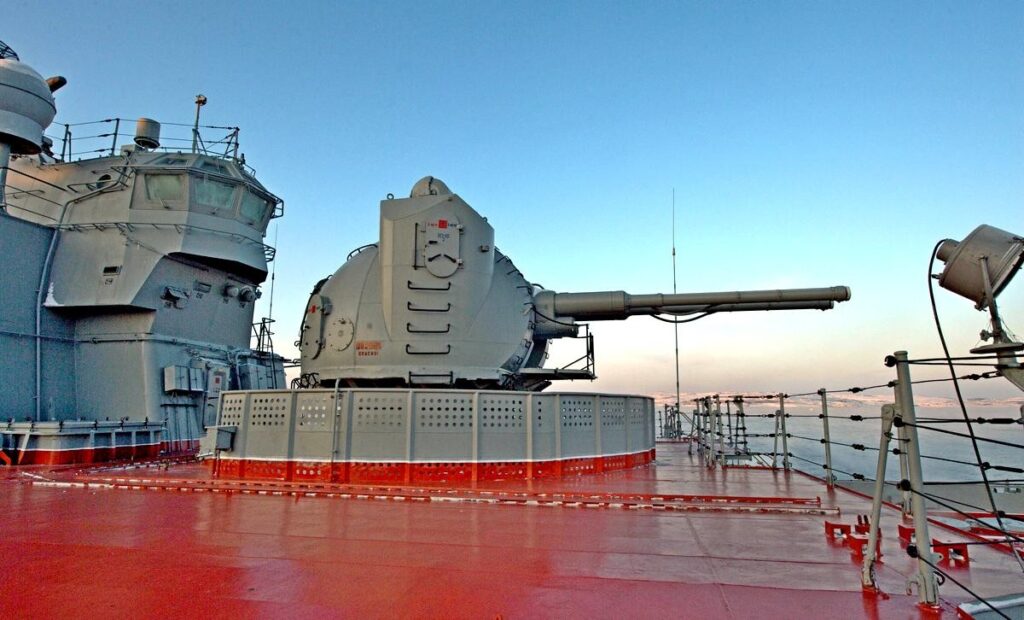
AK-130 is a universal artillery system. Rate of fire from 20 to 86 rounds per minute. Its twin 130-mm gun mount (AU) also makes it possible to fire at sea and coastal targets, and support landing forces with fire. The ammunition has several types of unitary rounds, for example, high-explosive fragmentation with percussion, remote and radio fuses. Barrel length – 70 calibers. Projectile flight range – 25 km, initial projectile speed – 850 m / s. The mass of a high-explosive fragmentation projectile is 27 kg. Vertical guidance angles: −10…+85°, horizontal guidance angle: +180°. Target tracking range – 40 km. All available ammunition is ready for firing. The MP-184 fire control system (developed by Amethyst Design Bureau) allows simultaneous tracking and firing of two targets.
ASW defence
RPK-6M “Waterfall”
RPK-6M “Waterfall” (NATO SS-N-16 Stallion.) anti-submarine missile/torpedo system. Other name RPK-6 Vodopad. Its torpedo missiles are capable of hitting enemy submarines at up to 60 km. A small-sized 400 mm UMGT-1 torpedo is carried by the system (41 knots, 8 km range, max depht 500 m). The missile is pointed to the targets, flies to it, dives into the water, leaves the torpedo running to the target area, performing a homing search until the target. Can be fitted with either a conventional or small nuclear depth charge.
RKPTZ-1 “Udav-1M”
RKPTZ-1 “Udav-1M” anti-torpedo missile system. 10 guide tubes, with automatic conveyor reloading, a reaction time of 15 seconds and maximum range of 3,000 m, minimum range of 100 m; The rocket weight is 233 kg.
RBU-1000 “Smerch-3”
The two “Smerch-3” RBU systems have a range of 1000 m, with a rocket weighting 196 kg. Located at the stern, upper deck port and starboard.
Miscellaneous
The standard countermeasures suite include two twin 150-mm PK-16 launchers as well as anti-electronic traps, decoys, and the towed decoy torpedo target with powerful noise generator. The three onboard navigation stations are completed by four electronic fire control systems for SAMs, the helicopter flight controls and an IFF system.
Air Group
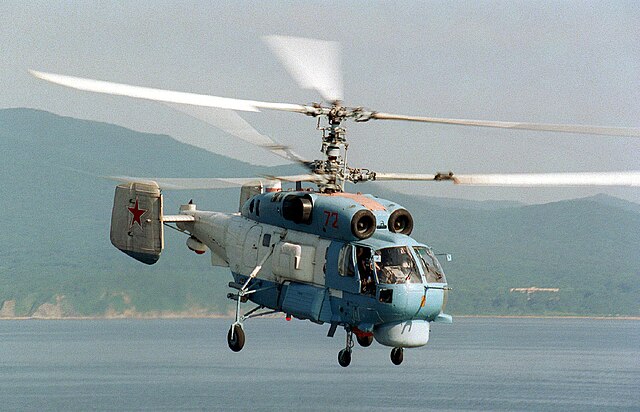
There is a flight deck at the stern. It had a unique landing pad but enough space for two more helopters to stand aside, with folded rotor blades. The Project 1144 Kirov indeed as planned with three Ka 25 “Hormone” multirole ASW helicopters. There is also a lift forward of the pad communicating to the hand below. The latter is large enough for two Ka-27 “Helix” (Project 1144.2) heavy multi-purpose helicopters. The are usaed in anti-submarine missions or as datalink relays for the Granit anti-ship missiles. Crew is three, pilot, navigator and hydroacoustic station operator. Max takeoff weight 11 tons, 4.5 hours autonomy at max ceiling 4300 m, max speed – 270 km/h, range 800 km.
The Ka-27 panoply includes the following:
-APR-2E anti-submarine missile (350 mm, 3,7 m, 575 kg solid-propellant rocket engine for 115 km/h underwater 100 kg payload). 2 minutes autonmy, search pattern 1,500 m 2° accuracy.
-Guided depth charges 94 kg, 55 km/h with active sonar guidance system.
-On-board radio-electronic system 1-for flight navigation in any weather, 2- for submarine search and tracking over 200 km
-Onboard fixed sonar system hull antenna, bulbous radome for search and detection of submarines at low and medium frequencies
-Towed automated sonar system with variable immersion depth (150-200 m) working at medium frequencies.
The helicopters also have a GPS based return and landing system in automatic mode.
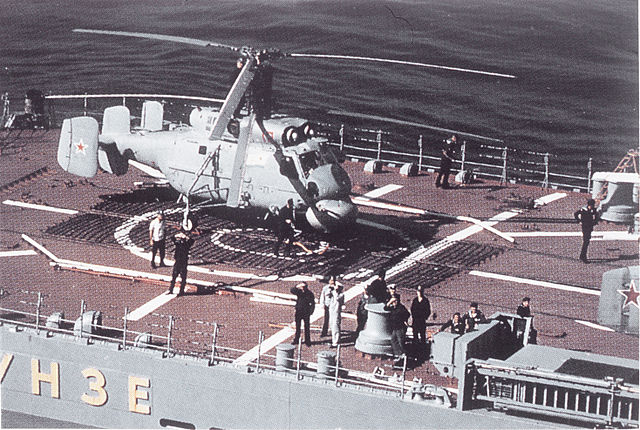
Ka-27 aboard Frunze

Author’s Illustration of the Kirov class
⚙ specifications |
|
| Displacement | 24,000t, 28,000t |
| Dimensions | 248 x 28 x 7,5m ( x x feets) |
| Propulsion | 2 shafts steam turbines 2xNR 150,000 shop |
| Speed | 32-34 kts |
| Range | Unlimited on nuclear, 1,300 nm at 17 kts steam only |
| Armament | 20x SSN-19, 1×2 SSN-14 (16), 12x SAN-6 (96), 2×2 SAN-4 (40), 2×2 100 mm, 8x 30 mm, 2×4 21-in TTs, 2×6 RBU-1000, 3 helicopters. |
| Protection | 100 mm CO and reactors, 35-75 mm ammunition stores. |
| Sensors | 2x Palm Front, Top Sail, Top steer, 2x Head Light, 2x Top Dome, 2x Pop group, 2x Eye bowl, 4x bass Tilt, Punch bowl. 2x Sonars Horse Tail, Horse Jaw (SPV), 8x Side Globe, 10 Bell, 4 Rum Tub, 2×2 chaff RL, see notes |
| Crew | 800 (as flagships), 720-740 in normal conditions. Expected -600 after mod. |
Cold War assessment
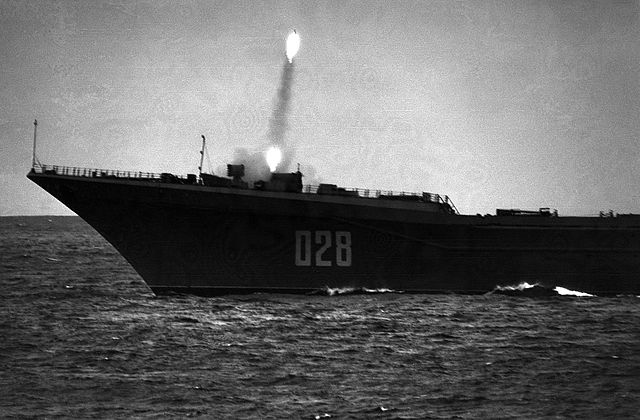
SA-N-9 fired from Frunze
If the term “battlecruiser” is frequently use by historians to describe them, both official records and NATO designations only mentions “heavy missile cruisers”. The only ship for the USN that could roughly match this was the unique 1960 USS Long Beach, matching its superior radar and command capabilities, nuclear power, but its missile armament and overall displacement and size did not matched the Soviet ships. None of the subsequent cruiser ever arrived close, especially not the almiost-contemporary Ticonderoga class, which were more destroyers with more advanced capabilities. The last true USN cruisers were the West Virginias in the 1970s. They were half the tonnage of a Kirov.
So when first known by US and NATO intel, Project 1144 vessels were a UNO (Unknown Naval Object) as long as soviet surface ships were concerned. Their massive size had little to do with the previous lineage (Kara, Kresta, Kynda) and more with the new oceanic, nuclear powered vessels preferred by the Soviet naval staff at the time. The quatuor of Kirovs indeed is a good match for the quatuor of Kirovs designed not long after. In fact they were even to be paired in all four fleets (Northern, Baltic, Black sea, Pacific) as complementary, organic their own battlegroup, with Krestas AAW, Kara ASW cruisers and Krivak ASW frigates. What the Kirovs lacked in air defence and ASW protection could be brought by the Kievs (with the reinforcement of a Slava class cruiser as carrier killer complement). The Kievs lacked on the other hand long range strike and antiship capabilities as the Kirovs.
In Brief
Heavy nuclear missile cruisers of project 1144 “Orlan” – a series of Soviet/Russian multi-purpose steam/nuclear (CONAS) guided missile cruisers for oceanic operations and fleet coordination, built at the Baltic Shipyard from 1973 to 1996: Kirov, Admiral Lazarev, Admiral Nakhimov and Peter the Great. Chief designer was B. I. Kupensky. The end design became the largest and most powerful non-aircraft carrier combat surface ships with nuclear power plant in the world, and record holder in terms of armament. According to NATO classification, the project received soon the term “battlecruiser” due to its huge size, armor and powerful armament, but it still remained a “large missile cruiser” in the Soviet inventory. As of 2020, only one, Peter the Great is operational, while “Admiral Nakhimov” is under modernization, expected completion in late 2023.
The Kirov class perception on the US/NATO side
 The Kirovs like the Kiev class are among the originals of the Soviet navy. Unmatched anywhere in the world, these four units are currently the most powerful surface units ever built outside aircraft carriers. Most experts playing mind games also insist that they could have wrecked an antire conventional battlefleet of WW2, including battleships, if staying beyond artillery range. We can obviously oppose the air strike force of aircraft carriers, but even in this case, a Kirov was designed for massive saturation fire. Unlike battleships of old missile cruisers have no active protection, except for subdivision below the waterline, albeit considerable protection was given to the Kirovs (the best of any guided missile cruiser to date). Their delicate electronic equipment still, would succumb to even small-caliber impact. But the Kirov’s own successive layers of protection ensures it is a though nut to crack for any opponent.
The Kirovs like the Kiev class are among the originals of the Soviet navy. Unmatched anywhere in the world, these four units are currently the most powerful surface units ever built outside aircraft carriers. Most experts playing mind games also insist that they could have wrecked an antire conventional battlefleet of WW2, including battleships, if staying beyond artillery range. We can obviously oppose the air strike force of aircraft carriers, but even in this case, a Kirov was designed for massive saturation fire. Unlike battleships of old missile cruisers have no active protection, except for subdivision below the waterline, albeit considerable protection was given to the Kirovs (the best of any guided missile cruiser to date). Their delicate electronic equipment still, would succumb to even small-caliber impact. But the Kirov’s own successive layers of protection ensures it is a though nut to crack for any opponent.
When the second ship, Frunze, was accepted into service in 1984, the US navy under the Reagan administration, as part of the “600-ship fleet” found a compromise solution: The return into service of the four veterans battleships of the Iowa class. These were completely rebuilt and modernized, armed with cruise missiles and state-of-the-art equipment. This choice may seem surprising, but was considered very rational at the time: Fully Updated (but at great cost) the Iowa reached beyonf the level of modern missile cruisers in addition to being fast, with unmatched armor protection invulnerable to conventional missiles as far as the hull is concerned, and above all if allowed to close in within 40 km of their opponent, cand do shortwork of any Kirov with their 16-in guns battery, with shells not fearing interference or jamming… In that way, by 1986-87, the Kirovs ultimately found their most serious antagonists…
The KIROV also featured a redundant and unique propulsion system called CONAS (Combined Nuclear And Steam). This was a solution that the US Navy had studied and rejected because of its complexity. They could be used for both speed and range, alternating if needed between reactors and conventional steam turbines, or combining both. However on the long run its nuclear reactors had a habit of being unreliable with a serie of incidents (only the most serious being public) making this conventional steam turbines used as a backup more often that not. This issue combined with dwindling resources after the collapse of the USSR, no clear missions and the cancellation of the carrier program and single Admirakll Kuzetsov barely operational, left them without purpose while having great maintenance costs. Two were thus mohballed soon.
Nicknamed “The Death Stars” in Russia in reference to star wars, they were litterally “festooned” with weaponry but this plethora of systems were a nightmare of EMI and mutual RF Interference. In the end, simultaneous use of all systems due to incompatibility by RF Emissions would have probably severely limited their capabilities while in combat in 1988-89. The recent example of the sinking of the Moskva in the black sea shows that no matter how well armed any warship, without proper upkeep and maintenance, it stays really vulnerable. Between this and incompatibilities of new systems installed explains why Admiral Nakhimov never-ending overhaul had reasons behind it. It is likely, if done properly, to replace the Petre Viliky as flagship in the next future.
Although not armored, these ships had a light shielding: 100 mm above the reactors, and 35 to 75 mm elsewhere. They differed between each other regarding their electronic equipment, and superstructure details. A fifth unit, the Dzerzhinsky was planned for 1995, and started in 1989, but the order was canceled and its structure started disassembled. Currently these four units are still on the lists of the Russian Navy. They are undeniably the flagship. With the fall of the USSR, these ships were renamed Admiral Ushakov, Lazarev, Nakhimov, and Petr Velikiy (Peter the Great). But their situation is hardly brilliant: The first two were temporarily removed from service for lack of fuel and maintenance. Nakhimov suffered from a reactor accident in the Mediterranean in 1990, its turbines filed, and repairs since drags.
Modern fate of the Kirov class
Rotary VLS cells for Kinzhal 3K95 short-range SAM system aboard Kirov class cruiser ‘Pyotr Velikiy’ [1091 x 615]
byu/casualphilosopher1 inWarshipPorn
According to the Deputy Minister of Defense of the Russian Federation Vladimir Popovkin, the Ministry of Defense of the Russian Federation has developed a program for the restoration of heavy nuclear missile cruisers. As of September 2009, the Russian Navy had one nuclear-powered missile cruiser, Pyotr Veliky, in service, and the possibility of restoring and modernizing the nuclear-powered cruiser Admiral Nakhimov, as well as Admiral Lazarev, was discussed. “We have several such ships left from the Soviet fleet. We have developed a program to restore them,” Popovkin said. According to him, the Ministry of Defense of the Russian Federation considers it expedient to have up to three such ships in the Navy, given that one of them will be in the Pacific Fleet and two in the Northern Fleet. The need to use heavy nuclear missile cruisers is dictated by the tasks of long-distance cruises and exercises, the Deputy Minister explained.
According to a high-ranking representative of the Main Staff of the Navy: “All Project 1144 nuclear missile cruisers in reserve will be returned to the combat strength of the Russian Navy by 2020”. Work will be carried out for the next five years. Then “Admiral Nakhimov” will go to the Northern Fleet.
During the ongoing repair of the heavy nuclear missile cruiser Admiral Nakhimov, instead of the previously installed P-700 Granit anti-ship missiles, the P-800 Onyx anti-ship missiles were installed. A similar modernization will also be carried out on the cruiser Pyotr Veliky.
The future according to the military:
piotr
The heavy nuclear-powered missile cruiser Pyotr Veliky is scheduled for her own modernization after completion of Admiral Nakhimov into the new 1144.3 program upgrade. Both ships will remain in the Northern fleet, part of the Joint Strategic Command in the Arctic. In 2021, the Russian MoD announced that “Project 1144 Orlan cruisers will be upgraded with Onyx, Zircon and Caliber missile systems, as well as the new Polyment-Redut anti-aircraft missile system “. “Admiral Nakhimov” however is in limbo since 1999, officially “under repair”. Work only ramping up by the fall of 2014 at Sevmash in Severodvinsk for a full modernization between 2015 and 2023 (Project 1144.3). Both cruisers will undergo weapons, communication, sensors upgrades as well as complete overhaul of their life support systems, internal arrangements, eletrical network and pipe systems and fittings. Nuclear reactors would stay unchanged, but with improved management system to ensure safety and continuous operation. What the Navy wants is to avoid all the issues oberved notably on Kirov and her sister. Lead ship Admiral Ushakov being laid up since 1991 due to serious power plant issue, was sent for disposal in 2016 and scrapped, and her sister followed. So the Russian navy is left with just two of these formidable “legacy” assets, but they are wanted up to date to stay relevant in a “new cold war” context .
Evaluation

Project 1144.3 Orlan-M2 upgrade project for Nakhimov.
Project 1144 cruisers were the first and last nuclear-powered surface missile carriers of the Soviet Navy, the first large-displacement ships built after a long break, and the largest military non-aircraft-carrying ships built by any state after World War II.
The size and cost of the Project 1144 missile cruiser are very large, while the shock functions are inferior to the cheaper submarine missile carriers of the Project 949 Granit and 949A Antey. The main function of the ship – delivering missile strikes against the US Navy aircraft carrier strike group (AUG) – is actually feasible only with a coordinated surprise attack (for example, in combination with a submarine attack on the same US Navy AUG). As a weapon of a possible retaliatory strike, the ship is significantly inferior to the Project 949 and 949A SSGNs due to greater visibility to the enemy and greater vulnerability.
The first weak point of the basic design was the vulnerability to low-flying subsonic anti-ship missiles. Close air defense on the first three is reduced to the Osa-M air defense system with low fire performance and relatively long reaction time, unable to shoot down incoming missiles below 25-60 meters. Only offset by AK-630 guns, its effectiveness is also considered unsufficient.
The second weak point is the multi-purpose nature of these ships, complicating maintenance, created lots of interference between systems, and a headache for the staff to determine its tactical and technical niche.
Last but not least, many NATO experts were impressed by the large strike capability of these ships, especially with the excellent SSN-19 aptly named “shipwreck”, which had no equivalent in the USN. The carrier ship however is less impressive, many considering it was a big, juicy and weakly protected target. All striking power and little protection. Indeed, despite having some armour in places, its thickness is a compromise and in no way sufficient to stop modern weaponry, wherever it is a torpedo, or a missile. Given nowhere the protection id above 100 mm or 4-inches, and not sloped at that, its effectiveness is limited to 5-in destroyer rounds, and only inside the hull. The fragile radars and superstructures are completely exposed.

Project 1144.4 the most radical reconstruction project for Admiral Nakhimov (cancelled). The only project today which is aimed at replacing these large ships as the Lider class “destroyers”.
Unlike a true battleship that can take enormous punishement, a Kirov could not stand a missile strike. So some said it was a “half-baked” idea, and with the required protection, 300 mm or 12-in and more steel armour and a full citadel encompassing the VLS, the design would have made more sense. However with the addition of some 5,000 tonnes extra hardened steel, so many changes would have been required, notably a greater powerplant to not loose speed, that the design would grow even larger, costlier and that included maintenance. The idea of a true missile battleship had never been incarnated yet, even by the Iowas which were conventional battleships with add-on missiles.
But the weak point of any of these hypothetical behemoths is the same anyway: A strike in their fragile masts and radar systems means blinding it. However with external data input from satellites, aircrafts, drones or other ship/submarine gathering data, a counter strike with missiles is still possible with an armoured ship which own detection capabilities (less the sonars) are gone. Future and new arms races will tell.
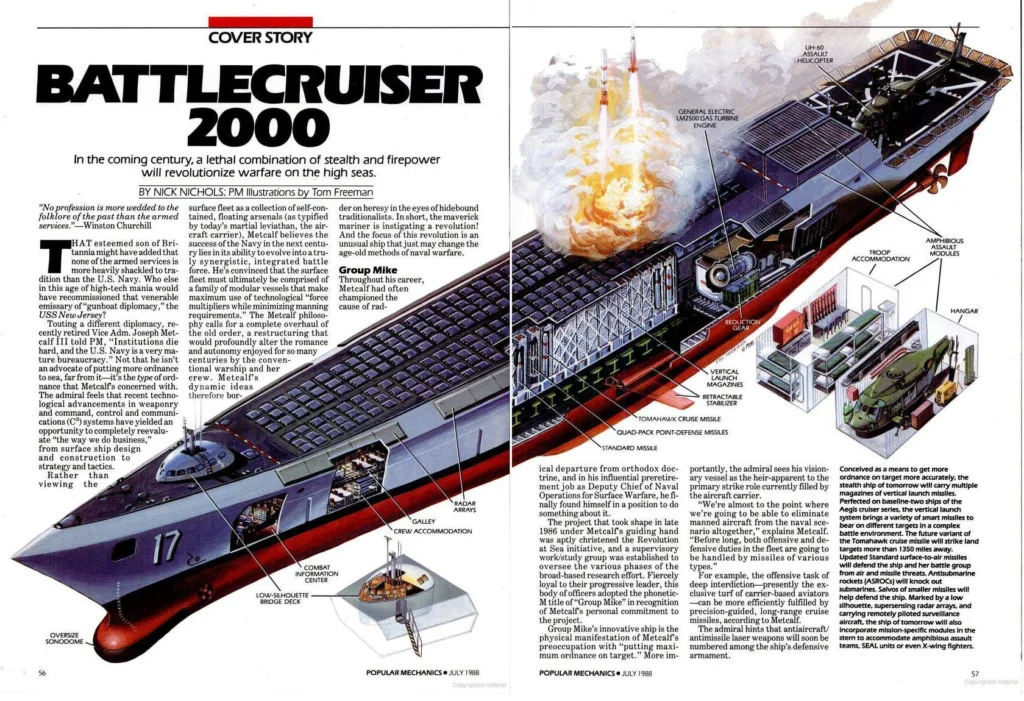
“Battlecruiser 2000”, a saturation missile cruiser proposal influenced by the Kirov design – Popular Mechanic July 1988.
Career of the Kirov class battlescruisers (still ongoing)
 Kirov (1977), 1992 Admiral Ushakov, scrapped.
Kirov (1977), 1992 Admiral Ushakov, scrapped.

On March 26, 1973, construction of the lead ship Kirov class, project 1144, started at the Baltic Shipyard. On December 27, 1977 she was launched and scheduled as a member of the 13th brigade under the construction and repair unit. On March 29, 1980, the crew checked in as her captain for completion, until she was accepted for service with the Baltic fleet, commissioned on December 30, 1980.
Four years of sea trials, testings and weapons qualifications in home waters were followed by her first international oceanic cruise, in 1984, her first first military campaign to the Mediterranean.
On May 18, 1984, there was an ammunition explosion in Severomorsk, while she remained in harbor and she wa sput in high alert, ready to shoot down any missile self-igniting in the blaze, and protecting other ships in the base. While sailing at the entrance to Kola Bay, her main turbo-gear gearbox GTZA No. 1 broke down. It happened when commander Gromov personally grabbed the telegraph handles on the navigation bridge for a full reverse. GTZA No. 2 was activated while the shaft line was disconnected through a soundproof coupling. In drydock, the bottom was cut and the massive planetary gearbox was unloaded, sent for repair to the Kirov Plant. After repair,it was loaded, centered according to marks and optics and the hull bottom batched up and closed.
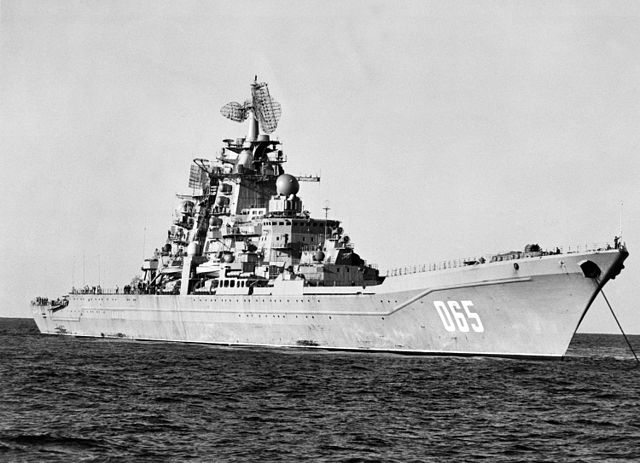
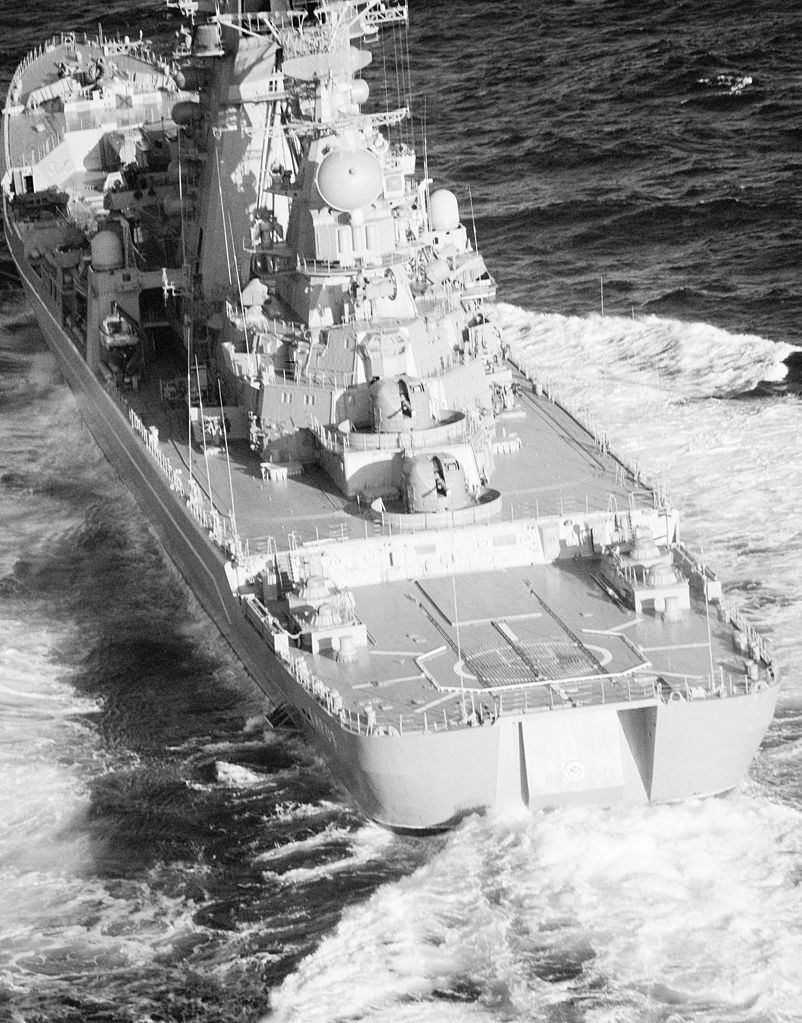
On April 7, 1989, after an urgent order assist the just sunken K-278 “Komsomolets” at 33.5 knots (more than on tests) she arrived to the scene and provide assistance for hours.
In 1990, Kirov was repaired due to a gas leakage in the primary circuit of the forward KN-3 reactor, fixed by the crew when she arrived at berth 7. The rest of the ship was serviceable, but irradation meant she was placed in reserve, 2nd category due to lack of funds. She needed cleaning and more repairs. Starting from 1991, she never ventured out to sea again.
In 1992 she was renamed “Admiral Ushakov” in honor of F. F. Ushakov and stayed in reserve. In 1999 at last the admiralty decided to have her fully repaired but also modernized in Severodvinsk.
In 2000-2001, repairs were started however new budget cuts and priorities meant the admiralty eventually decided to stop the modernization and by 2002 she was decommissioned and officially stricken from the fleet. By 2004 the name “Admiral Ushakov” was given to a new destroyer. She was provisionally renamed “Kirov”.
As of 2008, she was mothballed, planned for disposal but by 2009, according to the Deputy Minister of Defense Vladimir Popovkin, decision to restore her into service was definitely abandoned.
In 2011, however there was a new modernization plan as part of the Navy development program with a commission planned no later than 2020.
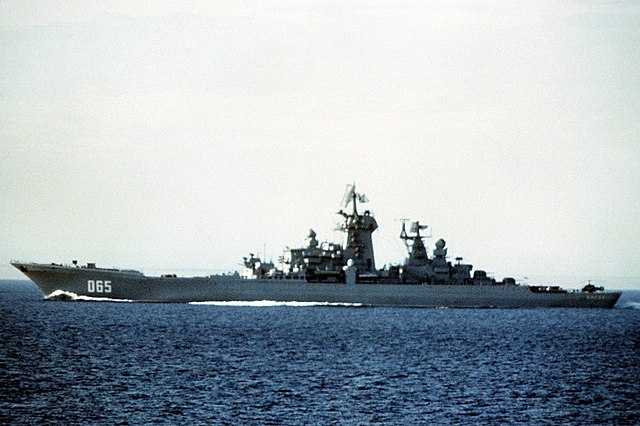
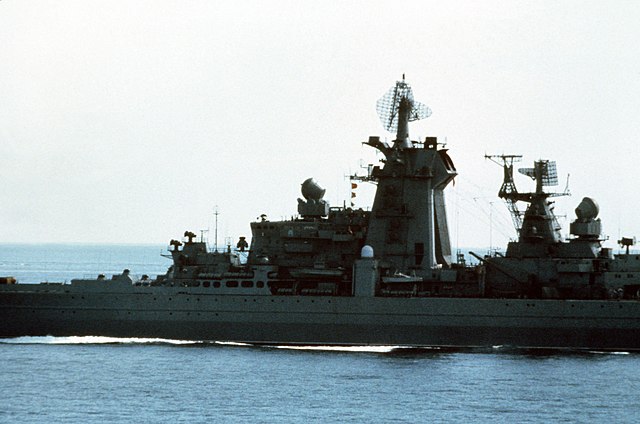
By the autumn of 2012, Dmitry Rogozin, Deputy Prime Minister of the Russian Federation, received a public appeal from the public relayed by the Kirov’s veterans organization.
Dear Dmitry Olegovich! You are being approached by thousands of people who at various times served on the nuclear cruiser Kirov, which is currently laid up in the city of Severodvinsk. In 2009, we turned to the President of the Russian Federation with a request to explain to us the further fate of the ship… We will not bore you with military terminology about the purpose of nuclear cruisers of this project, but let’s say in a nutshell: A nuclear cruiser represents the power of the fleet and the prestige of the country! Dear Dmitry Olegovich! Help us (and the country!) save our cruiser!
By the Chairman of the Council of Veterans of the nuclear cruiser “Kirov”, V.R., Secretary.
The cruiser “Kirov” was returned to the Navy and currently, there is still a modernization project being developed.
By December 2013, specialists from the Zvyozdochka Shipbuilding Center urged for the disposal of the cruiser’s nuclear core. Press secretary of the Zvyozdochka Ship Repair Center, Yevgeny Gladyshev on June 9, 2014 wanted a scrapping no less than by 2016. Budgeted by Rosatom in 2015 with a procdure by Zvyozdochka specialists, they proceeded to seal the dangerous reactor zone.
On April 25, 2015, there was a solemn raising ceremony of the Andrei cross flag for the 34th anniversary of the cruiser’s commission. August 2015 saw a final decision to scrap the cruiser with a tender for disposal announced by Rosatom. According to the tender the limit date for disposal was November 30, 2016. Spent nuclear fuel (SNF) unloaded at Zvyozdochka CS was to be sent in Italu for storage. As for now, the ship’s only surviving items are some spare parts for her remaining systers, flag and bell.
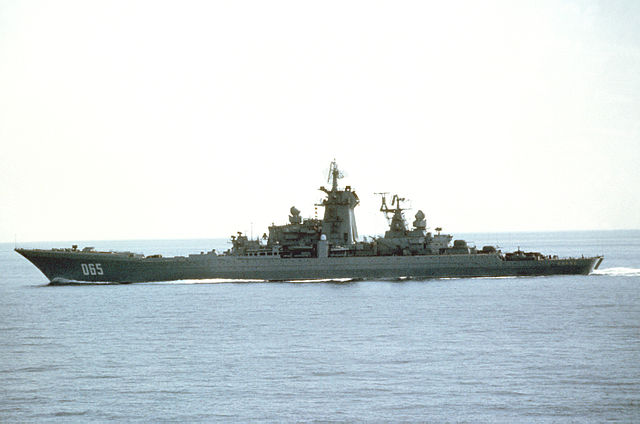
Captains:
Alexander Sergeevich Kovalchuk (1976—08.1984)
Sergey Vladimirovich Lebedev (1984—1989)
Vladimir Ivanovich Rohatyn (1989—1991)
Leonid Viktorovich Sukhanov
Oleg Anatolyevich Shirnyn (1994—1996)
Sergey Borisovich Popov (1996—2000)
Alexander Sergeevich Fadeev (2001—2004)
Pavel Kravchenko (2004—2005)
Andrey Leonidovych Chernenko (2005—2010)
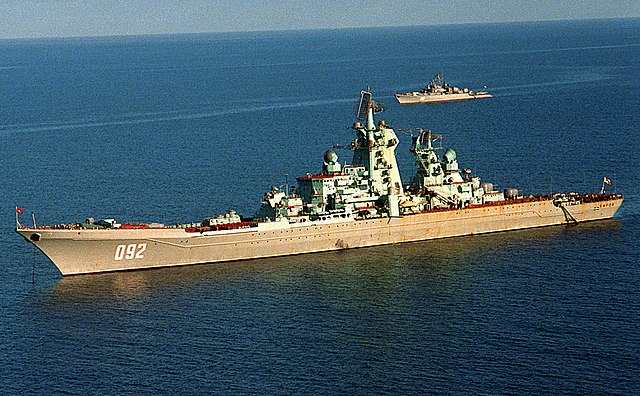
In popular culture:
The cruiser Appears in the 1982 Soviet film “Case squared 36-80”, is mentioned in Tom Clancy’s novel “Red Storm Rises”, hunting for convoys, sunk by a Norwegian submarine. It is mentioned in the 1984 television film Threads directed by Mick Jackson for the BBC also, colliding with the destroyer USS Callaghan in the Strait of Hormuz during the crisis. It is the focus of the Kirov book series by John Shettler in a scenario of 2017-2021 total modernization where other 1144 cruisers are dismantled for spare parts, crating the new flagship of the Northern Fleet and it went though time to August 1941 after a missile test, provoking history changes and alternative realities. It is also mentioned in “red October” novel adapted to a movie classic with Connery and Baldwin.
 Frunze (Admiral Lazarev 1992): In disposal.
Frunze (Admiral Lazarev 1992): In disposal.
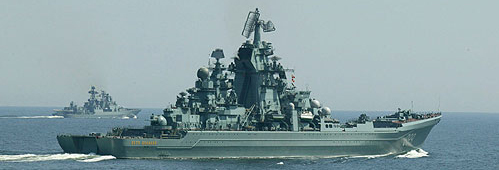
Battlecruiser Frunze
Laid down at the Baltic Shipyard she was the lead ship of the modified project 1144.2. Frunze was launched on May 26, 1981 and entered service in the Pacific Fleet on October 31, 1984.
From August 21 to November 22, 1985, she sailed from Severomorsk to Vladivostok, with ports calls to Luanda (Angola), Aden (South Yemen) and ports of Vietnam. Until September 1987, the commander was Captain 1st Rank Evgeniy Grigorievich Zdesenko, enjoying great respect from both the military leadership and personnel. At the time he left the ship, and against orders, the crew activated all existing sound devices, all rotating antennas for a ship’s salute, all conscript gathered for several cheers on the left side. He was succeeded by Captain 1st Rank M. Shcherbakov. No rrcored for 1988-91. By April 22, 1992, Frunze was renamed “Admiral Lazarev” according to the new regime post-communist numenclature, returning to the Tsarist navy traditions.
By 1993 an inspection concluded that due to absence of maintenance since 1991, she was no longer operational, and was mothballed, decommissioned from the fleet, and left rotting, anchored in Abrek Bay. In 1999, still lacking funds for repairs and maintenance, she was listed for disposal but by June 2000, small funds were at least secured to maintain her in a mothballed state, but contractors asked between 2 and 7 billion rubles to perform the minimal overhaul and modernization. On December 6, 2002, a fire broke on her board while bethered at Fokino but four hours later the fire was contained and extinguished.
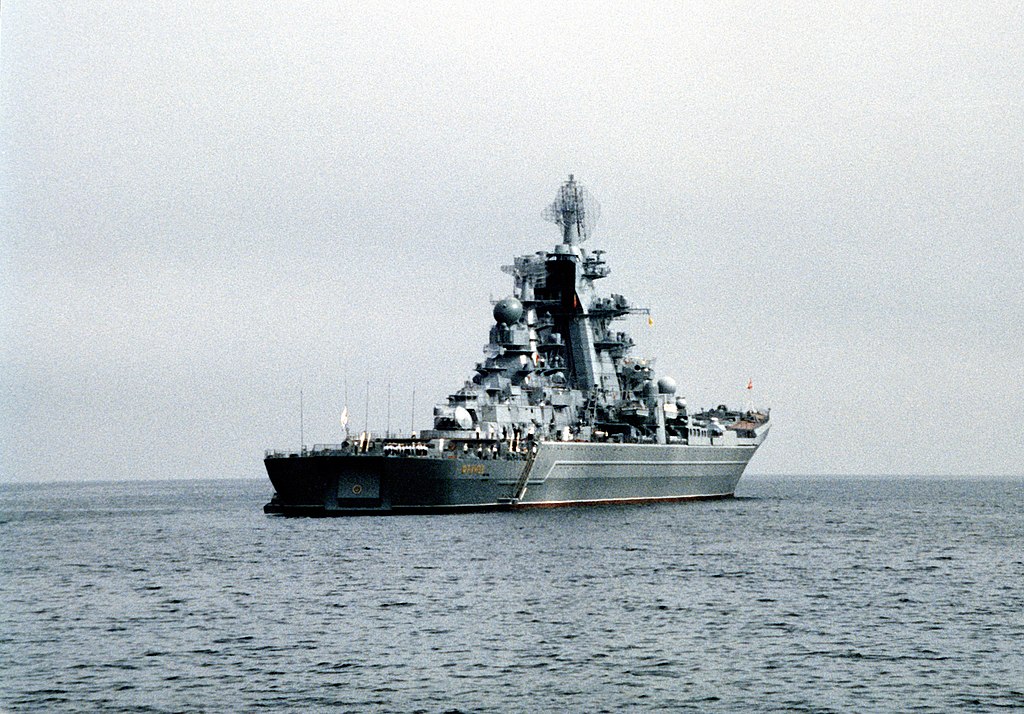
Aft view of the cruiser (US Navy)
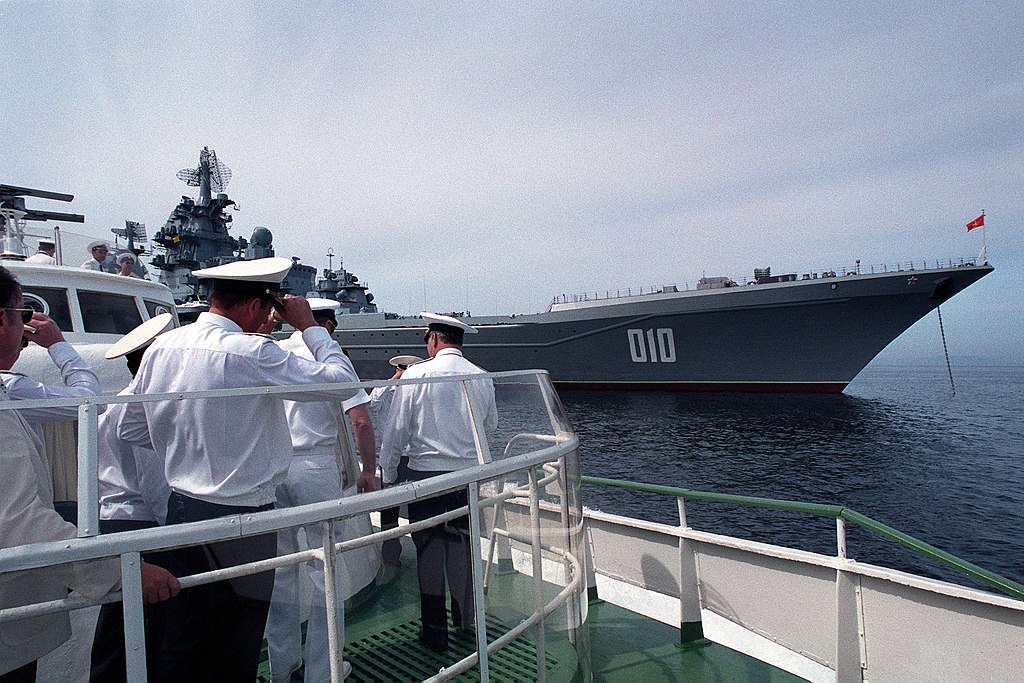
Frunze boarded by USS Princeton (CG-59) and USS Reuben James (FFG-57) staff during a 4-days goodwill visit
In 2004, funds were secured and she was delivered to the Zvezda ship repair center at Bolshoi Kamen. There, her nuclear power plants were unloaded but her mothballed period was extended. In 2005, after minimal work was done, she returned in the mothballs at Strelok Bay.
The reactor core could not be replaced she was again listed for disposal, indirectly confirmed by plans to transfer Admiral Nakhimov to the Pacific Fleet after modernization. However in 2011, the press stated a modernization was still planned and by December 17, 2014, the 30th ship repair plant of the Pacific Fleet completed her drydock maintenance for a future modernization. In 2015, the Navy announced she was to be scrapped in 2016 and by November no decision was taken. By April 18, 2019, Izvestia, citing the Ministry of Defense, reported her disposal by 2021.
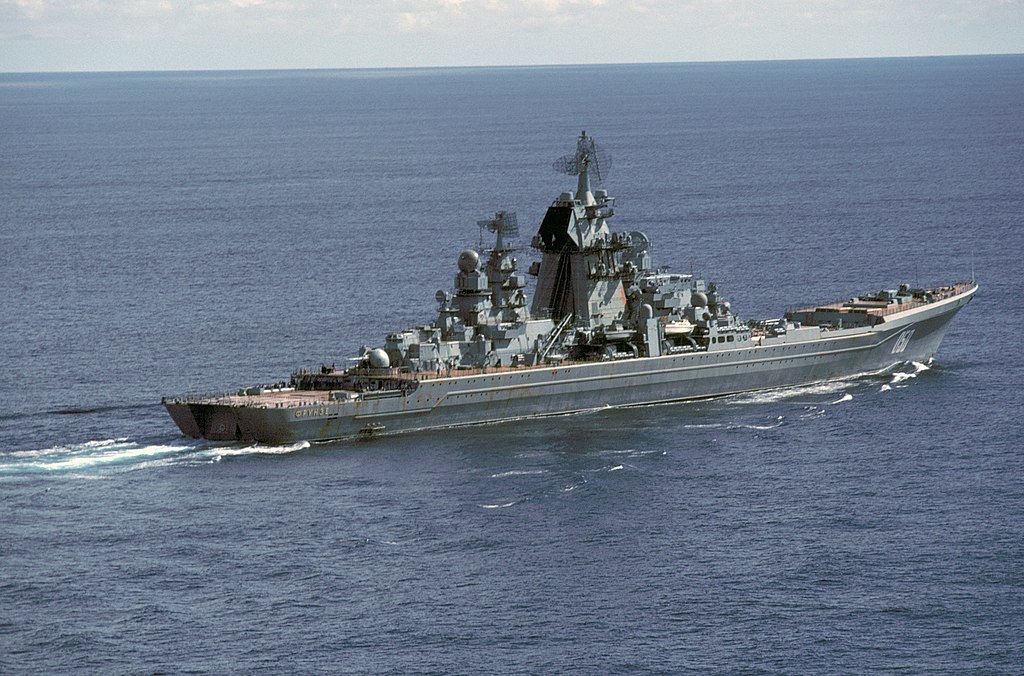
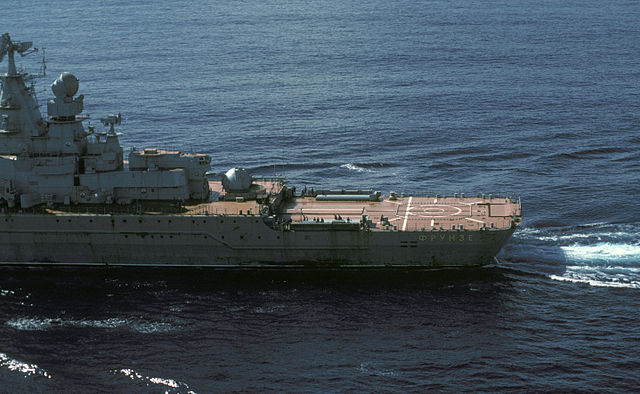
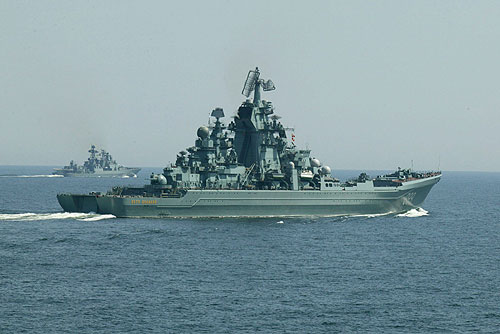
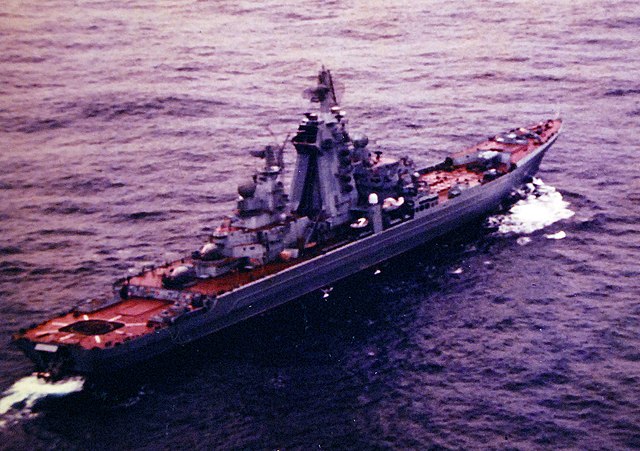
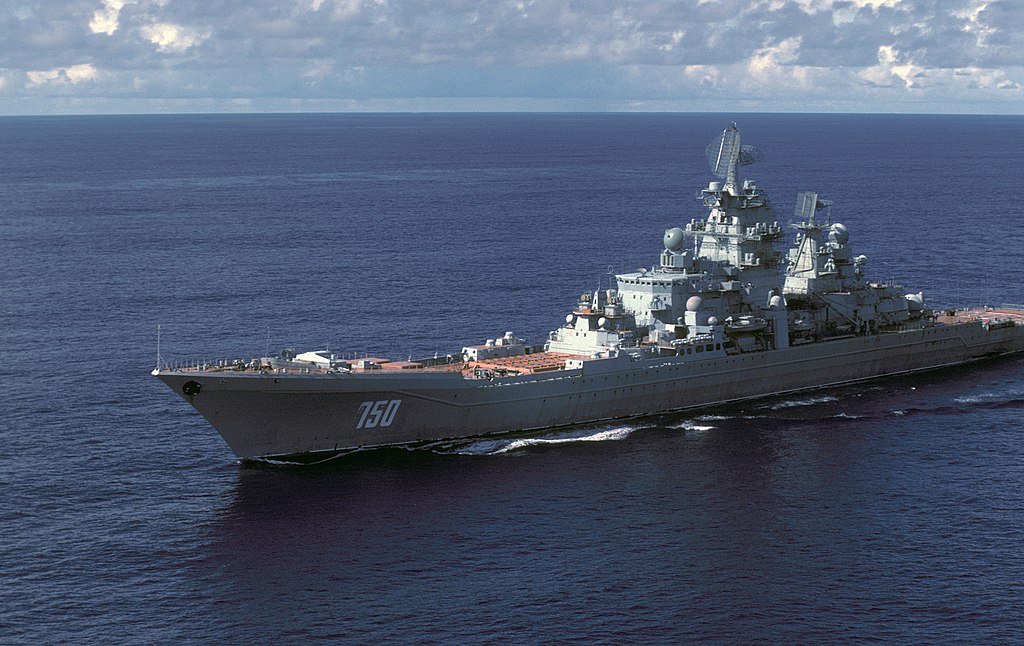
In 2022 modernization plans were announced abandoned for good due to improper funding, and still experts considered disposal inappropriate. On February 18, 2021, media, reported about a contract with the 30th shipyard for her disposal and she indeed was towed by April 30, 2021, for disposal, which is currently going on.
 Kalinin (1986) 1992 Admiral Nakhimov: Modernized 1999-2024
Kalinin (1986) 1992 Admiral Nakhimov: Modernized 1999-2024
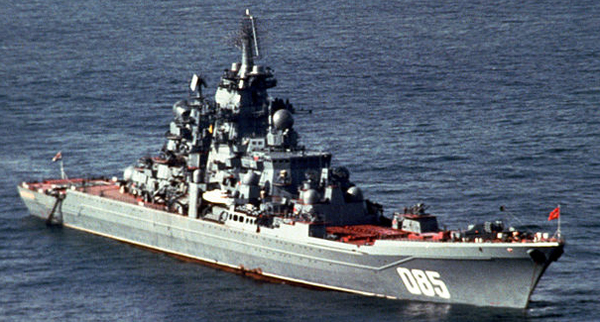
Kalinin 1991
Kalinin was laid down on May 17, 1983, launched on April 25, 1986 and was commissioned by December 30, 1988. Records for 1989-1991 are absent. It seems she did not made an overseas cruises but stayed in home waters. On April 22, 1992 she was renamed “Admiral Nakhimov”. By August 14, 1999, she was scheduled for modernization at Sevmash plant, Severodvinsk with the priority given to her electronics, updated with many western components. It was assumed that new modern digital systems installed and displays would be enough without modernizing her armament.
In 2008, modernization plans were adjusted, and this time her spent nuclear fuel was unloaded in September. By 2012, a new design was studied (Pr.1144.4).
On June 13, 2013, Sevmash was contracted by the Russian Ministry of Defense for a new, more torough modernization and planned recommission in 2018. Work started by December 2013 in drydock with support systems, unloading faulty equipment, de-wiring the whole cabling system, inspection and replacement of piping, etc.
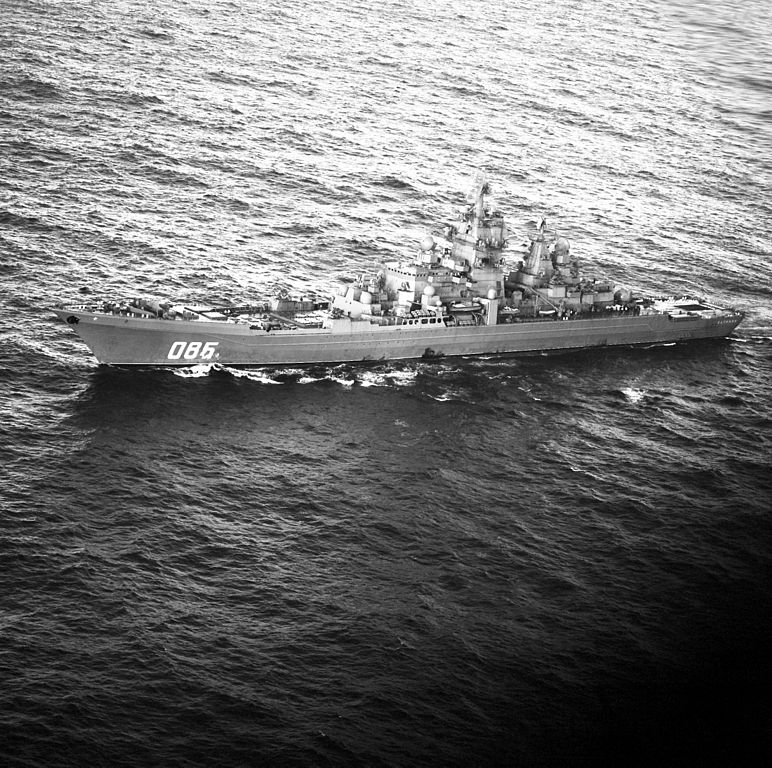
Kalinin in 1991
By January 24, 2014, Sevmash reported that work on her hull was completed and her dock was to be flooded, whe would moved elsewehere in 2014, conveyed with four specially made pontoons for transfer through the docks doors. On February 4, construction of the first pontoon was completed, then two additional pontoons previously used for the Vikramaditya aircraft carrier, and byJune 4, 2014, installed on her dock support structure, and by October 24 she was moved to the Sevmash completion pool.
On January 30, 2015 dismantling of internal arrangement went on and by November old equipment removed. She was completely gutted with new equipment stockpiled.
By February 2016 her hull structure was reinforced and priming was done. In 2017, the new date given for completion was 2020.
However it slipped again and the MoD announced Admiral Nakhimov would be completed by late 2022 due to numerous testing of the new equipments starting in 2021. According to the modernization plan, she was to be equipped with 80 UKSK 3S14 universal missile launchers (Kalibr, Onyx, Zircon), Fort-M and Pantsir-M air defense systems and new anti-submarine systems.
On August 19, 2020, Sevmash completed her drydock stage and moved her for a second stage of repair and modernization, mooring tests and a new completion date in 2023, then 2024, with reporting that her modernization already exceeded 200 billion rubles.
In 2006 already, decision was made to modernize her instead of completing Belgorod. However it is clear that she no work was done by 1999. By 2011 50 billion rubles were secured but this was judged insufficient to bring her back to active servicen when it was announced she would join the Russian Pacific Fleet, but by 2020 the Northern Fleet. In 2012 Sevmash General-Director Andrei Dyachkov stopped all work as the full modernization plans were not received from the Navy, resumed by January 2014. Originally at the time, her armament was to be 60 Zircon hypersonic anti-ship cruise missiles, Kalibr cruise missiles and navalized variant of the S-400 SAM system. In the following years, constant changes made by the Russian MoD required amendments to the contract. By 2022 the final armament plan was the following:
2x CADS-N-1 point defense gun/missile system
2x pop-up (lowered) SA-N-4 surface-to-air missile (SAM) launchers
20x SS-N-19 cruise missile launchers
12x SA-N-6 surface-to-air missile (SAM) launchers
8x SA-N-9 surface-to-air missile (SAM) vertical launchers
She left the drydock by August 2020 with sea trials expected in 2023 and precisions about the final armament.
On 30 May 2023, Sergei Shoigu announced that Admiral Nakhimov sea trials were expected in the last months of 2023, full completion in 2024. However recently sea trials were pushed back to Spring 2024.
Admiral Nakhimov in her current form is the most advanced modernization of the Kirov class, and a formidable asset, but future will tell if issues with the interferences between these weapons systems had been solved. In the current state of affairs, it is likely she would be operational in 2025 rather than 2024, unless it is given priority. She is still intended for the Northern Fleet.
 Yuri Andropov (Piotr Veliky 1992)
Yuri Andropov (Piotr Veliky 1992)

Piotr Velikiy
Yuri Andropov was laid down at Beltic shipyards on 11 March 1986, she was launched on 29 April 1989 but not completed before the collapse of the USSR. In 1992 Andropov was renamed Piotr Veliky, “Peter the Great”. Still, she completed her acceptance trials in November 1996, and she was transferred to the Northern Fleet, at Severomorsk, now flagship of the Northern Fleet.
on 16 October 1996 she witnessed an international incident. As she was flown over by a Swedish Saab 37 Viggen in the Baltic Sea, the fighter arrrived on a collision course with a Russian aircraft and crashed at sea as trying to avoid it. The pilot died.
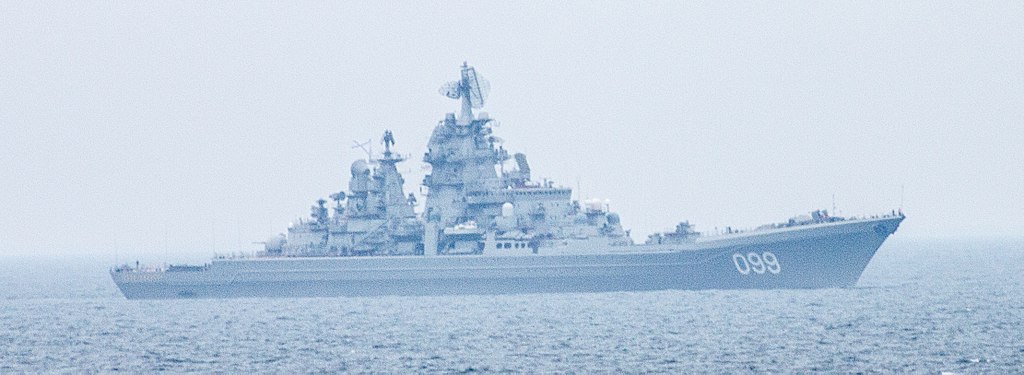
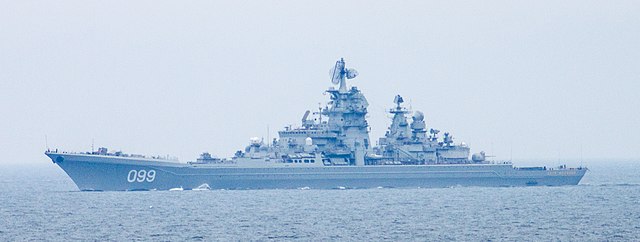
In August 2000, Pyotr Velikiy made her first sortie in the Barents Sea as command vessel for largest naval training exercise in a decade. She became the designated target for the Oscar-II class submarine K-141 “Kursk”, conducting evasive maneuvers when all communication with Kursk was lost. The rest is history. It is now established she suffered from torpedo detonations. Pyotr Velikiy guarded the area during the ill-fated salvage operation of 2001.
In March 2004, Russian Navy Chief Admiral Vladimir Kuroyedov declared Pyotr Velikiy “unfit for service” due to faulty engineering maintenance. On 19 April 2004 she entered the floating drydock PD-50 for for her hull to receive a new primer, repairs and steering system inspection, completed later that year. In August she sortied for her post-fixes trials and from September 21 to October 22 2004 she escorted the carrier Admiral Kuznetsov, with destroyers Admiral Chabanenko and Admiral Ushakov into the north-western Atlantic in the largest Russian naval exercise so far.
By 8 September 2008 was announced her cruise to the Caribbean Sea and exercises with the Venezuelan Navy, escorted by destroyer Admiral Chabanenko. She left Severomorsk on 22 September but proceeded to the Mediterranean, stopping at Aksaz Karagac, Turkey and by 6–9 November, Toulon, in France, a first for a Russian ship of that size. She passed Gribralter back to the Atlantic on 10 November, and arrived at La Guaira, Venezuela on 25 November just as the Russian President Dmitry Medvedev arrived for a state visit. She took part in VENRUS-200 exercize on 1–2 December 2008 and was visited by officials afterwards;
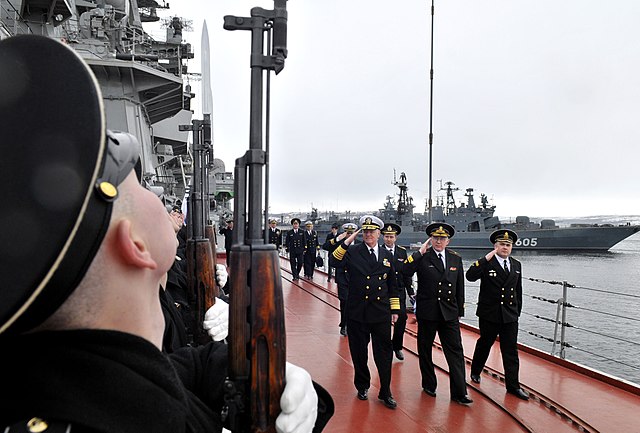
CNO Gary Roughead boarding Piotr Veliky, honor guard.
She visited Panama on 5–10 December, Nicaragua on 13-15 December, Havana on 19 December but crossed the Atlantic to Cape Town in South Africa and by 11 January 2009, the chief of the Russian General Staff announced a joint naval exercise with the Indian Navy. After three days in Cape Town she proceeded to the Indian Ocean, via Mormugao and to the state of Goa. She trained with INS Delhi and returned in African waters for INDRA-2009 exercise and more Indian ships. On 12 February she intercepted pirates in three boats off Somalia. On 10 March she was back to Severomorsk after a record six-month cruise.
On 30 March 2010, she started a second six-month deployment starting with the Atlantic Ocean, Mediterranean, suez and the Indian Ocean for combined maneuvers with the Black Sea Fleet. 14 April saw her stopping at Tartus, Syria. In September the base was announced leased for Russian warships, now having a strategic relay in Middle East. She later trained with the cruiser Moskva in the South China Sea for joint exercises with the PLAN and naval review on 5 May. They ended their voyage in Vladivostok fpr the Vostok-2010 Pacific fleet exercise. On 29 September she was back to her homeport after 28,000 nautical miles (52,000 km; 32,000 mi) covered.
By September 2013, Pyotr Velikiy led another fleet in the Northern Sea Route.
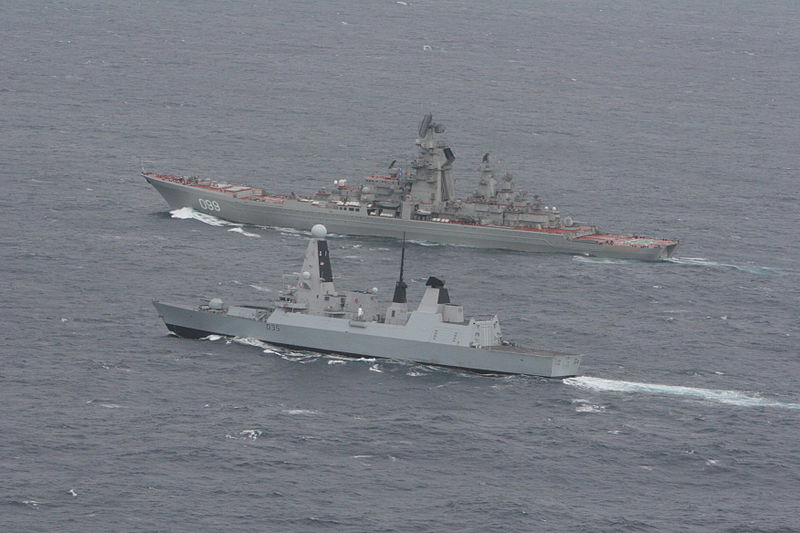
HMS Dragon shadowing Piotr Veliky in the channel, 2014
2014 saw her in a sortie with Admiral Kuznetsov, tankers Sergey Osipov, Kama and Dubna, tugboat Altay a Ropucha-class landing ship via the English Channel and the Northern Atlantic, shadowed by HMS Dragon. Later she transited to the Eastern Mediterranean and took part in an operation off Syria with the Chinese frigate Yancheng.
In May 2016 she started training off Northern Russia and by 15 October left Severomorsk with Admiral Kuznetsov for another sortie in the Mediterranean (with auxiliaries and two Udaloy class destroyers), again to support the Syrian government fighting at Aleppo. By July 17, 2017 she left Severomorsk again, escorted by Dmitry Donskoy, for Navy Day celebrations in Kronstadt via the deep enough Storebælt Danish strait.
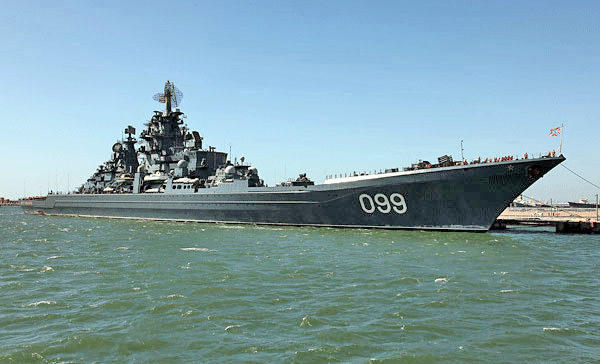
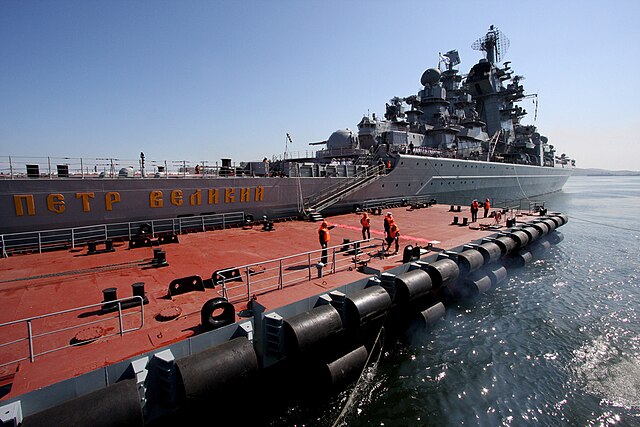
Piotr Veliky in 2010 and 2012
On 6 April 2019 she was back in the Barents Sea with the cruiser Marshal Ustinov and submarines for an exercize and by 10 October, she made another exercizes with 15 warships, submarines, and auxiliaries.
On 29 May 2020 this was a repeat of the same routine and by July, she made another exercize, with life fire from her and the cruiser Marshal Ustinov, shooting their Granit and Vulkan missiles at the range. On 24 May 2021 same routine, again with Marshal Ustinov. On 7 June she took part in another 20-ship exercise, same by July 2021 and from 15 September, with life fire.
On 29 January she performed an air defence drill in port and by 15 February escorted by the frigate Admiral Gorshkov she returned for drills in the Barents Sea and by 15-17 March she trained between Norway and Iceland, shadowing a large NATO naval exercise.
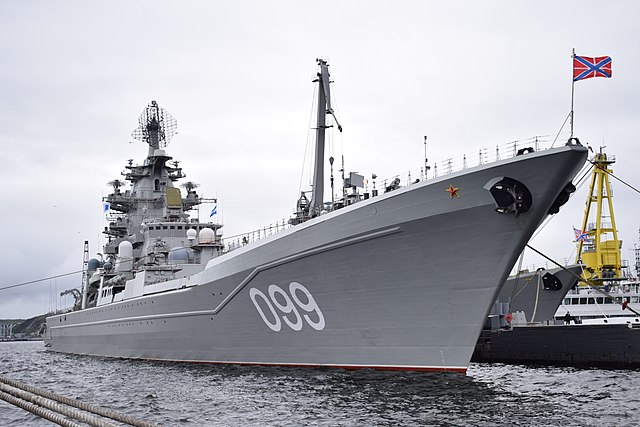

Pdt. Medvedev aboard Piotr Veliky during a stay in St Petersburg
On 18 April, same routine. She took part in the Navy day parade in July. By August life fire exercize with the destroyer Admiral Ushakov and later joined by Admiral Levchenko, for an eastwards trip along the Northern Sea Route. They later all transited to the baltic to meet for the parade in St. Petersburg. By October and November, same routine. On 20 April 2023 the MoD announced she was to be decommissioned once Admiral Nakhimov was recommissioned, and her modernisation would not take place.
Her current status is uncertain but she still had not been decommissioned.
Read More
Books
Conway’s all the world’s fighting ship 1947-95
Armi da guerra, De Agostini, Novara, 1985.
Bishop, Chris (1988). The Encyclopedia of World Sea Power. New York: Crescent Books.
Miller, David; Chris Miller (1986). Modern Naval Combat. London: Salamander Books.
Links
Middleton, Drew (13 March 1981). “Pentagon likes budget proposal, but questions specifics”. The New York Times. p. A14.
“Russia is Trying to Restore a Giant Nuclear Battlecruiser—It’s Not Working Out”. Forbes.
White, Ryan (21 February 2021). “Russia to scrap nuclear battlecruiser Admiral Lazarev”. Naval Post.
“Upgraded Nuclear Cruiser to Rejoin Russian Navy in 2018”. RIA Novosti. 13 June 2013.
“Russia: four submarines and two cruisers to be scrapped by 2021”. Navyrecognition.com.
Disposal of the heavy nuclear missile cruiser “Admiral Lazarev”. Federal Treasury 4 May 2021.
“Handover of Admiral Nakhimov battlecruiser to Russian navy postponed — source”. TASS. 7 April 2021.
The “Zircon” missiles definitively determine Russia’s technological superiority over the United States. Ruspolitica.ru 28 October 2016.
A fundamentally new fuel has been created in Russia for hypersonic cruise missiles. vesti.ru 17 March 2016.
kreiserkirov.ru/”>kreiserkirov.ru
ru.wikipedia.org project 1144 Orlan
secretprojects.co.uk soviet-cruiser-projects.1171/
https://ru.wikipedia.org/wiki/%D0%9A%D0%B8%D1%80%D0%BE%D0%B2_(%D0%B0%D1%82%D0%BE%D0%BC%D0%BD%D1%8B%D0%B9_%D0%BA%D1%80%D0%B5%D0%B9%D1%81%D0%B5%D1%80)
web.archive.org russian-ships.info project 1144.htm
on korabel.ru/ Lazarev
lenta.ru/ petr velikye
web.archive.org rosatomflot.ru/index.php?menuid=33
web.archive.org navylib.su/ships/1144/02.htm
web.archive.org atrinaflot.narod.ru/
missilery.info granit
snariad.ru c-300f/
web.archive.org flotprom.ru/news
tass.ru/
iz.ru
web.archive.org https://flotprom.ru
Globalsecurity.com
nationalinterest.org might-be-worlds-last-living-battleship-98012
nationalinterest.org kirov-class-what-makes-russias-battlecruisers-such-naval-powerhouse-207305
businessinsider.com bring-back-battleships-2021
ww2.dk/
naval-technology.com/projects/kirov/
ria.ru/
ria.ru/
lenta.ru/news/
web.archive.org bz.ru/
web.archive.org www.korabel.ru/
sakhalianet.x10.mx kirov_class_battlecruisers_01.htm
en.missilery.info fort
navy-matters.blogspot.com kirov-class-battlecruiser.html
Videos
Full review on matsimus
3D
Model Kits
General query on scalemates
It was covered of course by Trumpeter to 1:350 and 1:700. Also by Cyber Hobby and dragon at 1:700.
Note: First published on Aug 10, 2017 (7 years ago)

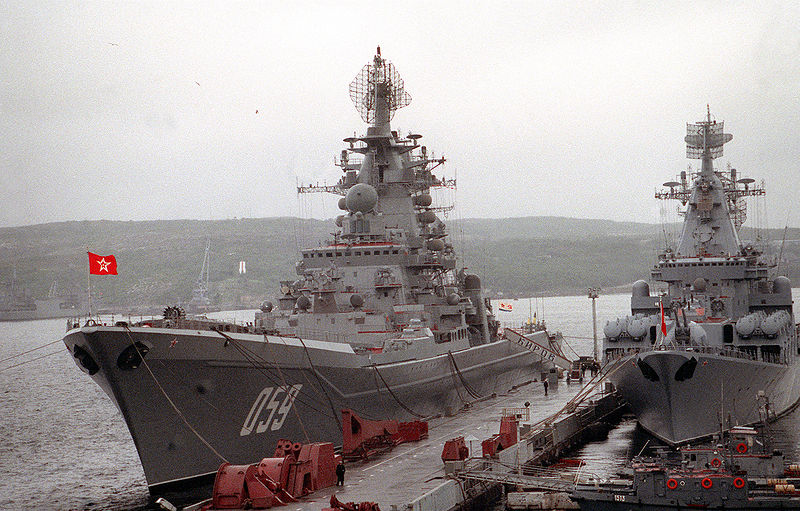

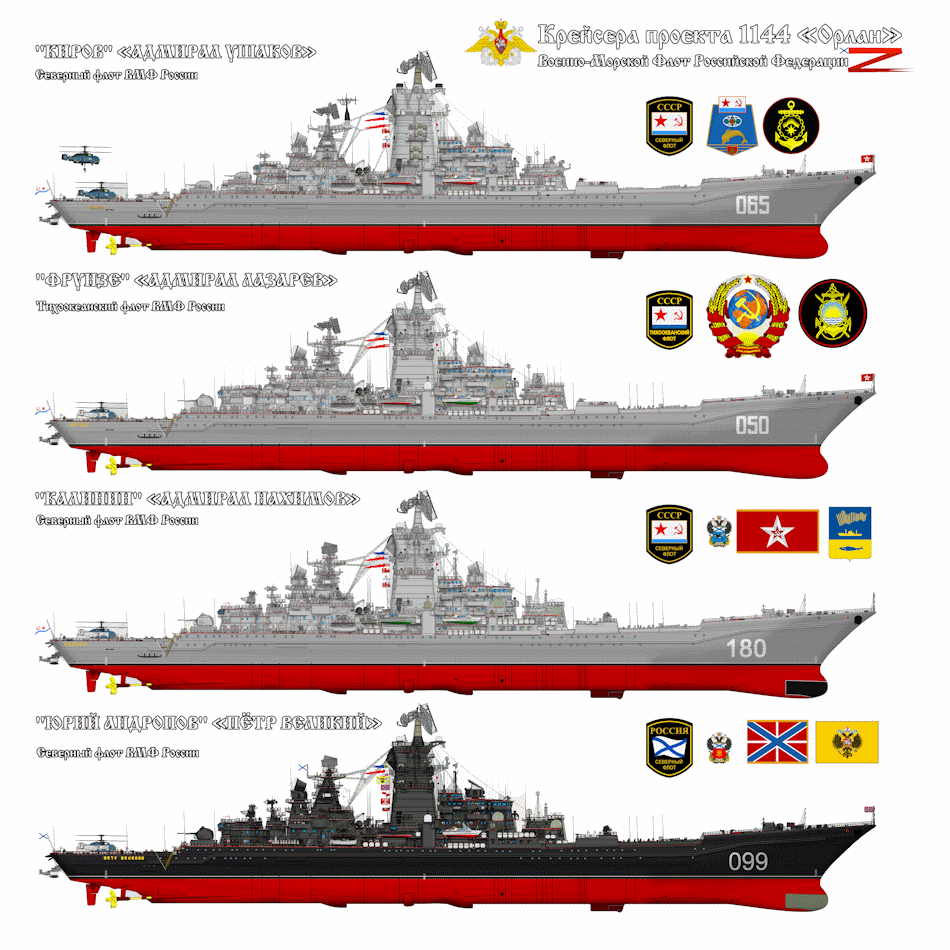
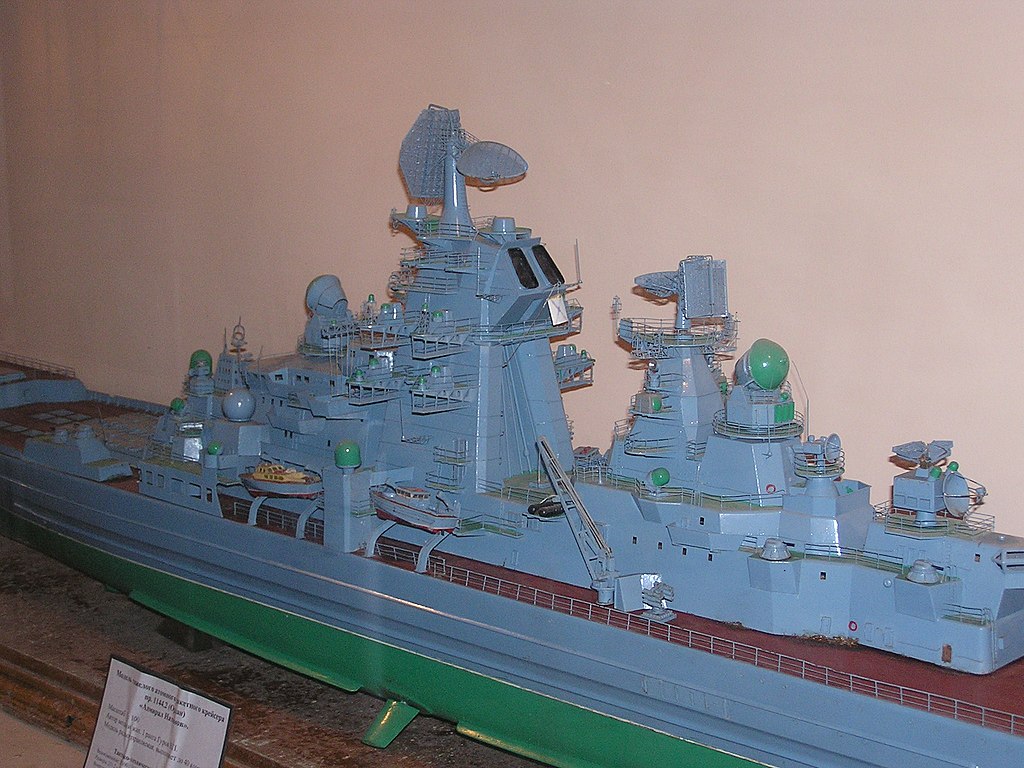
 Latest Facebook Entry -
Latest Facebook Entry -  X(Tweeter) Naval Encyclopedia's deck archive
X(Tweeter) Naval Encyclopedia's deck archive Instagram (@navalencyc)
Instagram (@navalencyc)





 French Navy
French Navy Royal Navy
Royal Navy Russian Navy
Russian Navy Armada Espanola
Armada Espanola Austrian Navy
Austrian Navy K.u.K. Kriegsmarine
K.u.K. Kriegsmarine Dansk Marine
Dansk Marine Nautiko Hellenon
Nautiko Hellenon Koninklije Marine 1870
Koninklije Marine 1870 Marinha do Brasil
Marinha do Brasil Osmanlı Donanması
Osmanlı Donanması Marina Do Peru
Marina Do Peru Marinha do Portugal
Marinha do Portugal Regia Marina 1870
Regia Marina 1870 Nihhon Kaigun 1870
Nihhon Kaigun 1870 Preußische Marine 1870
Preußische Marine 1870 Russkiy Flot 1870
Russkiy Flot 1870 Svenska marinen
Svenska marinen Søværnet
Søværnet Union Navy
Union Navy Confederate Navy
Confederate Navy Armada de Argentina
Armada de Argentina Imperial Chinese Navy
Imperial Chinese Navy Marinha do Portugal
Marinha do Portugal Mexico
Mexico Kaiserliche Marine
Kaiserliche Marine 1898 US Navy
1898 US Navy Sovietskiy Flot
Sovietskiy Flot Royal Canadian Navy
Royal Canadian Navy Royal Australian Navy
Royal Australian Navy RNZN Fleet
RNZN Fleet Chinese Navy 1937
Chinese Navy 1937 Kriegsmarine
Kriegsmarine Chilean Navy
Chilean Navy Danish Navy
Danish Navy Finnish Navy
Finnish Navy Hellenic Navy
Hellenic Navy Polish Navy
Polish Navy Romanian Navy
Romanian Navy Turkish Navy
Turkish Navy Royal Yugoslav Navy
Royal Yugoslav Navy Royal Thai Navy
Royal Thai Navy Minor Navies
Minor Navies Albania
Albania Austria
Austria Belgium
Belgium Columbia
Columbia Costa Rica
Costa Rica Cuba
Cuba Czechoslovakia
Czechoslovakia Dominican Republic
Dominican Republic Haiti
Haiti Hungary
Hungary Honduras
Honduras Estonia
Estonia Iceland
Iceland Eire
Eire Equador
Equador Iran
Iran Iraq
Iraq Latvia
Latvia Liberia
Liberia Lithuania
Lithuania Mandchukuo
Mandchukuo Morocco
Morocco Nicaragua
Nicaragua Persia
Persia San Salvador
San Salvador Sarawak
Sarawak Uruguay
Uruguay Venezuela
Venezuela Zanzibar
Zanzibar Warsaw Pact Navies
Warsaw Pact Navies Bulgaria
Bulgaria Hungary
Hungary

 Bundesmarine
Bundesmarine Dutch Navy
Dutch Navy Hellenic Navy
Hellenic Navy Marina Militare
Marina Militare Yugoslav Navy
Yugoslav Navy Chinese Navy
Chinese Navy Indian Navy
Indian Navy Indonesian Navy
Indonesian Navy JMSDF
JMSDF North Korean Navy
North Korean Navy Pakistani Navy
Pakistani Navy Philippines Navy
Philippines Navy ROKN
ROKN Rep. of Singapore Navy
Rep. of Singapore Navy Taiwanese Navy
Taiwanese Navy IDF Navy
IDF Navy Saudi Navy
Saudi Navy Royal New Zealand Navy
Royal New Zealand Navy Egyptian Navy
Egyptian Navy South African Navy
South African Navy






























 Ukrainian Navy
Ukrainian Navy dbodesign
dbodesign
Wait, so the Kirov didn’t have a whole lot of armor? Now that is something I didn’t know. Did they not put a whole lot on because they wanted to have more space for ammunition and to allow it to have it’s impressive speed. Apparently this thing can outrun destroyers from what i’ve heard
Hello Aaron
Armor is not that relevant if you can kill any surface ship with more precision with missiles, including some using small tactical nuclear warhreads. The main point about these ships was their “battlecruiser” nature. Fast, unprotected but armed for saturation fire against any opponent. There was a large debate in the US during the Reagan administration about the appropriate response to bring to the Kirovs. Eventually the Iowa were modernized and reactivated as a consequence as it was theorized that these ships had some chances of survival against missiles and their artillery was still able to destroy unprotected superstructure radars and FCS, making any modern vessel blind. There are still gaping holes in this strategy like fail-safe adn back-up systems, autonomous missiles and the fact the Iowa themselves depended on radars and FCS for their artillery to be efficient. There are still debates about some protection to be used around central ops rooms and AEGIS today. BTW Both the Iowa and Kirovs were capable of 32+ knots.